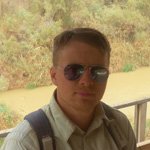2018 Southeast Asia
2018 Southeast Asia
For the next trip to South-east Asia I chose Philippines, where I spent most of my time. Apart from that, I also went to the state of Sabah in the Malaysian Borneo, and to the Sultanate of Brunei. My 4-month trip gave me an opportunity to see the picturesque beaches and water caves, although I also crossed the jungles and mangrove forests on small boats. I had the opportunity to see the Orangutans and proboscis monkeys, and met a lot of good people with sense of humour. I apart from that I managed to climb the highest peak of the island of Borneo – Mt Kinabalu. Both the Philippines and Malaysia are the countries of sea food, exotic fruit and coconuts, that taste the best on beaches under palm trees. The blue waterfalls located in the jungles were also unique.
The 2018 travel plan
About a month ago I came back from my long journey through south-east Asia. I planned my trip for 3 months, but it was so good and I was so happy in Asia, that I stayed 4 months. Southeast Asia is a very popular region because of its natural beauty and the pe two peculiarities of nature, even though other tourists prefer good food and massages. I’ve been to Southeast Asia many times for many months, and each time I choose different countries. This time I chose the Philippines as my main destination, because so far apart from the Philippines, I had crossed almost all the countries in that region. In addition, I was also able to make a very interesting trip around the state of Sabah, in the Malaysian Borneo, and in the Sultanate of Brunei.
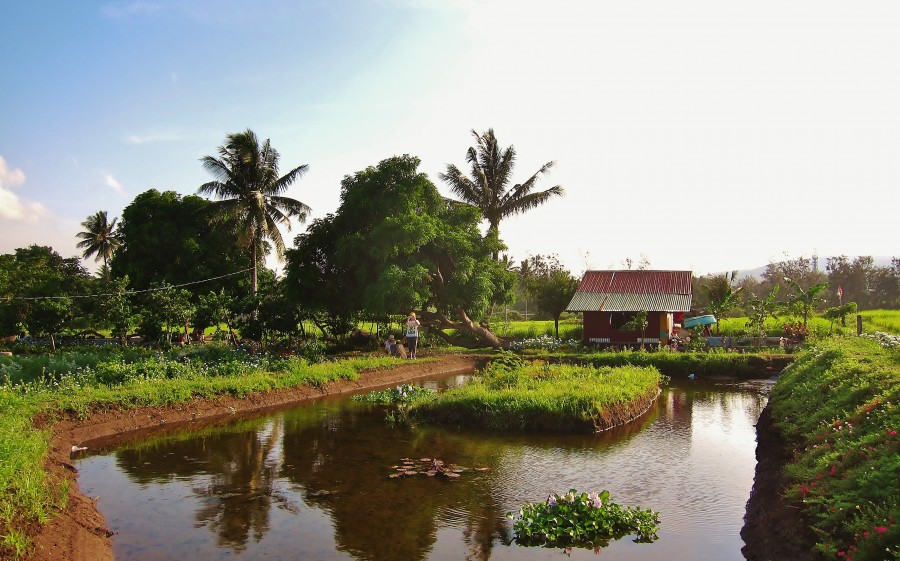
The rural landscape of the Philippines.
Due to the fact that the Philippines is an island country, many times I travelled by ferries and small boats. I also often travelled by bus, and hitch-hiking was good in Borneo too. The distances between some of the Philippine islands were so big, that it was not worth taking a boat, especially that flying in the Philippines is very cheap. Most often I used Air Asia and Cebu Pacific, both on internal flights and those outside of the Philippines. I mention this, because twice I planned my flights in such a way, so I could have longer stop-overs and see additional places again. For example,when I flew from the Semporna archipelago in the Malaysian Borneo, to Cebu City in the Philippines, I stayed for half a day in Kuala Lumpur and then in Singapore. Of course, I’ve been to those cities before, but many years ago, and that’s why I wanted to go out and see the main places again. I always do this when I have the opportunity.
I realize that in two or three months I would not be able to see the whole of the Philippines, that’s why during this trip I plan to see the entire archipelago of the Visayas, while with my travel companions I intend to see the southern part of Luzon and Bohol, because they only have one month. Palawan Islands, Mindanao, northern Luzon and a number of smaller islands, such as Mindoro or Siargao, I will leave for the next time. As for Malaysia, I’ve been everywhere except Sabah, and that’s why this time I travelled only around that one state of the island of Borneo. I’ve already been to Brunei, but I think it was too short, and that’s why this time I wanted to see more.

Tarsier – the smallest primate in the world, the endemic species of the island of Bohol; Philippines.
My trip turned out to be a great success, because I stayed one month longer, I saw more than I planned, and didn’t have to hurry. Below, there is a short but enriched in useful information travel report about most places that I visited. That way, I want to give an overview of my trip, while the exact travel reports will be in full report section of my expeditions. In this article, I will try to include different photos than in the news section of the same countries.
The first trip around the Philippines
I planned my expedition around the Philippines for many years, and I knew that it would be a different experience than in other countries of Southeast Asia. During my travels I learned that each country in south-east Asia is different, because despite the similarities, people in every country have developed national customs and specific cultures. Although in Burma, Thailand, Laos, Cambodia and Vietnam the prevailing religion is Buddhism, after all, each country is different, in each country there are different temples and different architecture. The selected nations of Southeast Asia are similar to each other, but certainly not the same – what proves the national identity of each of those nations. The seriousness of national identity is what I by the way try to teach in the section titled: “The Politics of Truth”.
The Philippines are a Catholic country, because it was the colony of Spain in the years 1521 – 1898. Today, many cities and villages, as well as street and surnames, are of Spanish origin. Also, the Catholic church is very popular in the Philippines, and it is closely related to the culture of this country. I give this information, in order to show that different countries in the same region of Asia can differ widely. Looking at Filipinos from the racial side, they are definitely different from Thais or Vietnamese.
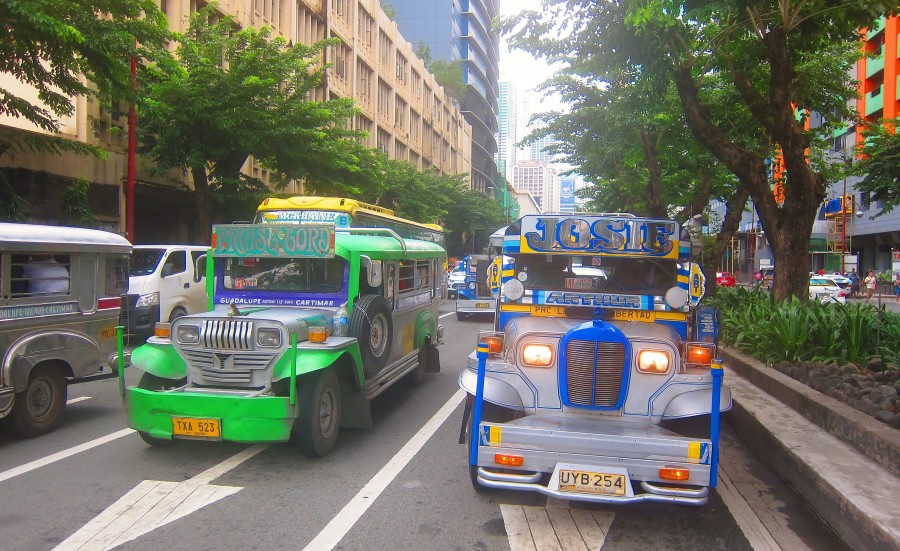
The iconic jeepney is a traditional means of transport in the Philippines.
The Philippines also became an American colony, when she decided to remove the “democracy” imposed by Spain and introduce her own. Thanks to this, it is easy to communicate in English with Filipinos, but on the other hand, unfortunately because of America, the Philippines has become a sex-tourism destination. It is not a coincidence that the largest centre of prostitution in the Philippines is located near the former American military base in Clark. Today the American base is already gone, but the city turned into a brothel has stayed.
Manila and south Luzon
I of course started in Manila, where I saw the Spanish Fort Istramuros, a great Catholic cathedral, and I also travelled around the city on a board of adventurous jeepneys. I stayed in the Makati district, where there were many hotels, restaurants and also dental offices (which I recommend in the Philippines). On the other hand, there were also a lot of prostitutes in the tourist district; and worst of all, there were also men dressed like women, witj make ups like creepy dolls, trying to sell themselves to tourists. It was disgusting, repulsive! As if that that was not enough, there were also street vendors offering viagra. I thought: “Well, so that’s how it’s done in the Philippines.” On my last day in Manila I went to the zoo, and then to the Rizal Square and the Chinese Garden After that I took my female travel companions and went south.
During the first part of the trip we travelled in the island of Luzon and stopped in Legaspi, from where we took four-wheeled vehicles to the Mayon volcano. I saw beautiful nature, palm trees, banana trees, the Casagwah ruins and the spectacular Hoyap-Hoyopan cave. Everywhere we went there was great nature, coconuts and cocoa, mango and rambutan fruit on the trees. Our next stop was the city of Tacloban, from where I went on a trip to the national park, I saw a few waterfalls and swam in the river by dramatic rock formations. It was also our first experience of the Philippine cuisine, Filipino countryside and the Filipino way of people. The majority of houses were made of bamboo and they were covered with palm leaves.
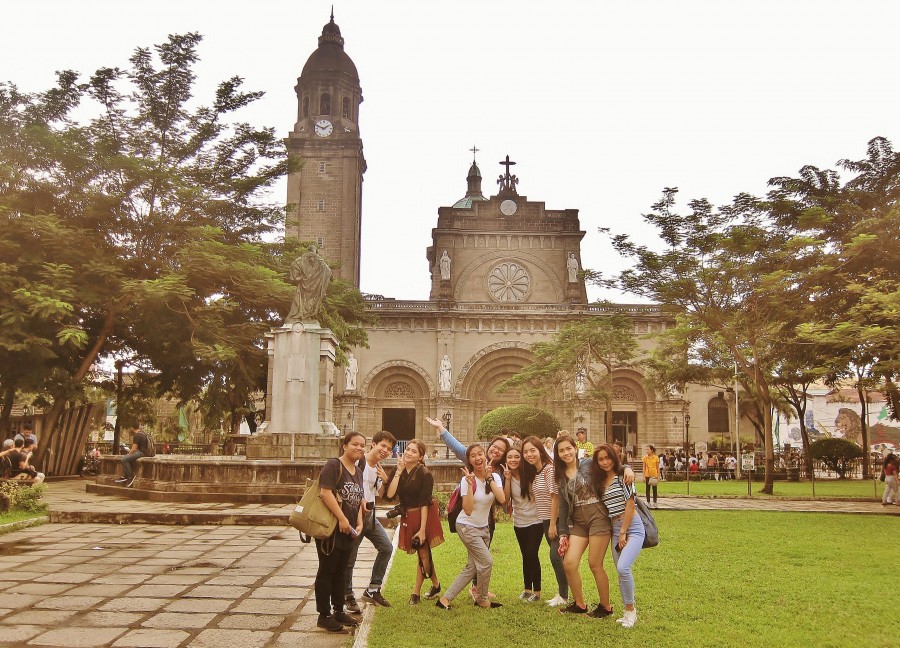
Cathedral in Manila.
The islands of Leyte and Samar
My next stop was Tacloban – a small and pleasant but also a dirty town, where I decided to stop to take a break on the way to the south. Our first trip from Tacloban was a trip to the beach of San Jose, but this one was not attractive. It was full of concrete and planes flying low overhead, but at least water was warm. We went to San Jose mainly because we couldn’t wait anymore for a contact with sea. The Sohoton Caves and Natural Bridge Park National Park on Samar island was much more interesting. We organized a canoeing trip and we went on foot through the areas where the kayak was not able to go through anymore. We also sailed under a picturesque rock bridge, and then we had an exotic meal in a house made of bamboo and palm leaves. The next day we went to see a waterfall behind the park, where I swam in the natural pool. A small town of Sebey turned out to be a very pleasant experience, and also on Samar, where people were very interested in the only Whites around. In Sebey, we had a good meal in a bamboo hut, prepared by a local family.
About 3 km behind Sebey there was a local beach, which was also very beautiful, It was called Bacubac. That’s what we’ve been waiting for. In the end, we found ourselves on a wide and long beach, with white sand and coconut palm trees. I think that’s what my happiness is truly about, because I’m a minimalist and I don’t need a lot to be happy. A bamboo hut under palm trees, and people who honestly smiled at me – that’s all I needed. Of course, the Filipinos were very excited to see three “polar bears”, because they don’t see us very often. To Tacloban we hitchhiked on the back of the truck.
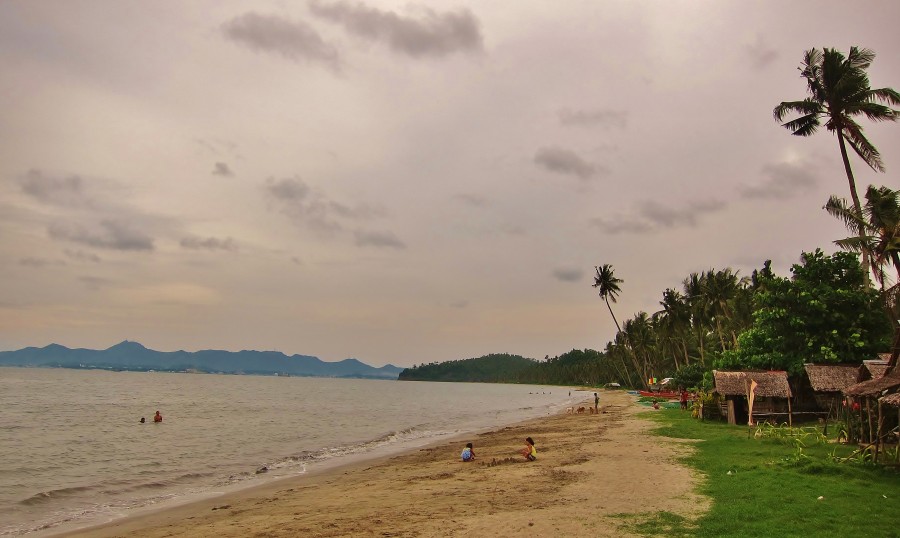
Beach in a little known Bacubac on the island of Samar, at dusk.
I noticed that Filipinos lived simple lives under coconut and banana trees and they ran their small businesses. These were usually small stores behind wall made of bamboo, where they sold coconuts, or ran their barbecue and cooked from home. Very often in the Philippines, the residents grilled meat in front of their homes and they put pots on the table with the food they prepared. I liked contributing to local economies. From the adventurer’s point of view, it was a simple, interesting life, and these were the traditions which I wanted to see. That was enough to make me happy. On the beaches, Filipinos were usually busy building or renovating fishing boats, or they were fishing. Then, there were not only chickens and pork on the grill, but also fish. I liked dorado and the flying fish the most. The food leftovers did not get wastes, as I was always accompanied by dogs and cats.
South Luzon and Samar island were only pleasant and valuable stops, because most of the time with my women I intended to spend on the very popular Bohol and the adjacent Panglao. We didn’t want to hurry too. We were heading to the port of Bato, where we were supposed to board for the port of Bohol, but decided that we would stay in Polompon. Polompon turned out to be a very nice little town with a good fish market, grilled chicken and a wide selection of exotic fruits. Sitting at San Juan beach we ate lansunis, rambutans and mangostine, whilst enjoying the sea view. This means that in our seemingly rich and well-supplied Europe, we still don’t have everything.
We also took a trip to the paradise Kalanggaman island, with white sand, palm trees, turquoise lagoon and a narrow sandbar. Kalanggaman is a perfect island for taking photos for postcards of perfect places. In Polompon we had a very nice time, and although we planned to stay only one day, we stayed 3 days. The Philippines not only captivates with its beauty and pleasant lifestyle; but it is addictive and makes travellers want to stay longer.
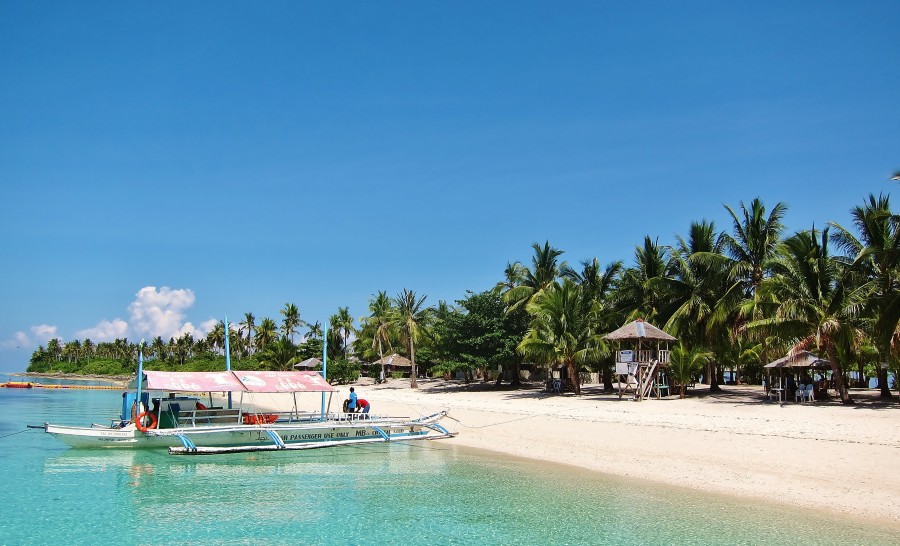
Kalanaggaman Island, Leyte. This is one of those places that prove the beauty of the Philippines.
Our last place in Leyte was a port town of Bato, where we slept on bamboo beds, ate suppers by the sea, and went to a poor village, strolling between small boats. Children who lived in wooden houses on tilts were very interested in us and asked questions, although adults wanted to talk to us too. I noticed that in the Philippines, which is a less visited destination, people react with greater interest when they see Whites, than in the more frequently visited countries of the region, what makes the cultural experience more realistic. Sometimes all the dark faces were looking at us, what made us feel like snow leopards that escaped from the zoo. Our white race is a rare species in the Philippines.
The islands of Bohol and Panglao
We spent most of our time on Bohol, and although we saw the whole island very well, first we stopped at the Anda beach, where there are the best beaches, water caves and a tourist paradise. Anda was quiet and secluded, and it was there, where together with my white women I experienced a quiet, rural life of the Philippines. Whilst strolling among banana trees and coconut palms, I reached white beaches with palm trees leaning to the sea, and then water caves, which gave me the biggest pleasure. Among the many trips we also took a motorbike tour to the complex of waterfalls hidden in the jungle, called Cam Umantad, on the way stopping for a barbecue between rice fields.
Then we moved to the Alona beach, on the adjacent Panglao island, which is louder and more touristy, but still beautiful. I personally preferred calm Anda, although I think that Alona should be seen too. When we’ve had enough of the beaches, I took my women on a week-long tour of central Bohol. We of course saw Chocolate Hills and the smallest primate in the world – tarsiers, but we also took a river cruise, we saw butterflies farms, botanical gardens and an interesting zoo, where my little blonde fed a young lioness from the bottle. It was a beautiful time among exotic nature, picturesque views, and in the company of Asian animals.
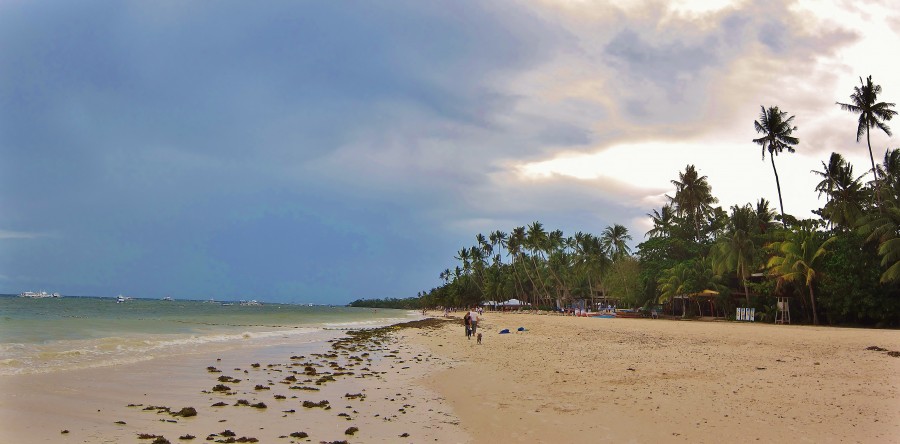
Beach in Panglao.
We usually had our meals in roadside places, made of bamboo and palm leaves. Before I escorted my women to Tagbilaran, from where they had a flight, we had returned to Panglao, from where we sailed to Balicasag island, to swim with sea turtles, and then to the sandbar partly over water, called the Virgin Island. I also took my women to the Hinangdanan water cave, which I also do recommend.
When I was alone, I spent the night in a hotel cell in Tagbilaran, and the next day I sailed to the Siquijor island.
Siquijor island
Siquijor is a small island near Bohol, which attracts travelers primarily with its beautiful and adventurous waterfalls in the jungle. As soon as I reached the port of Larena, the first night I spent on a bamboo bench under banana trees, and in the morning I rented a moped, because this is the best way to explore this island. I was heading towards Siquijor town, where I had my base for a few nights, but first I stopped at the blue pools surrounded by mangrove trees, called the Guiwanon Spring Park. I walked on a bamboo footbridge, I bathed in a mangrove forest and talked to Filipino women who were doing laundry. In Siquijor town I lived in a bamboo house in the garden for 500 pesos for two nights. I saw an interesting fish market, an old church and a bell tower, and after a few days I went on a trip around the island. I stayed on the Paliton beach, where I spent a whole pleasant day. I swam, I picked shells, and walked on the beach looking at boats and rock formations. I don’t even know when the day passed, that’s why I went back to my bamboo house, and the next day I went for atrip around the island.
I started my trip around Siquijor from San Juan town, where most of the time I spent in a pool under palm trees, called the Capilay Spring Park. I stopped for grilled meat under palm trees, which is a common way of eating in the Philippines. The rest of my trip around Siquijor was limited to riding through rice fields, and jumping over blue waterfalls. On Siquijor there are many peaceful, secluded waterfalls hidden deep in the jungle, such as for example Locong. Driving through banana trees and palm trees I also got to Kawasan waterfall, and to the cave of the same name, which was located right under the waterfall. Getting there was not easy because I had to go down through the jungle, but the beauty of the blue waterfalls was enchanting. Siquijor is also a good island for observing the rural life of the Philippines, because many times I saw farmers plowing rice fields with wooden plows, and using buffaloes.

Kawasan waterfall on Siquijor island.
However, by far the biggest attraction of Siquijor is the three-story waterfall called Cambugahay, reachable from Lazi. There are ropes, swings and bamboo platforms, prepared for bouncing and jumping into the water. The jungle, rock formations, blue waterfall and beautiful birds – these are the unique attractions of that picturesque place. I was also in the town of Maria to see the old church, and from there I went to Salangdoon beach. The beach itself was nice, but its main advantage was the 10m cliff, from which I jumped into the sea. I jumped 8 times, whilst being strongly encouraged by the Chinese tourists. On the way back I stopped again in Maria, to play pool with the Filipinos and eat the delicacy of the Philippines – squid adobo. In the center of the Siquijor island there is also deep and a very attractive Cantoban cave. I had to squeeze through small gaps, watch out for rocks on the ground and on the ceiling, and walk in the water to the level of my waist. In Cantoban cave I had to climb the higher parts of the trail, including the underground waterfalls. It was an adventure that I needed.
My last night in Siquijor I spent in the Larena port, because at 6 am I had a ferry to the Negros island.
Negros island
Negros Oriental
Negros is not the most visited island of the Visayas, because rushing travelers most often choose Bohol and Cebu instead. However, I spent a few weeks there and it was beautiful. I started my journey around the island from Damaguette, which is the main city of Negros Oriental. Damaguette turned out to be a very nice seaside town, where it was always possible to eat fish straight from the sea and drink coconuts in the evening under palm trees. For travelers Damaguete is a city of seaside walks, restaurants and massage, although Damaguette is also a convenient base for nearby places.
My first trip from Damaguette was a trip around the small town of Valencia, which is surrounded by wonderful nature. From Valencia I hitchhiked to the Casaroro waterfall, which is 70m high and lies deeper in the jungle. Casaroro is a longer trip because after reaching the parking lot, I had to go down the stairs, and then I walked along the large rocks along the river, in the jungle. After about 40 minute walk I saw a high waterfall of great strength. Every time I see a new waterfall I always swim in it. This is part of my adventure manifesto, and that’s why I also swam in the very cold Casaroro waterfall, and I had a shower running down from 70m. Then I came back the same way, walking along the river and avoiding huge rocks and banana trees I finally reached the top of the stairs. Later, I was lucky again because I found abother car and returned to Valencia, and then immediately went to the double Pulangbato waterfall. In this very tourist place there are two waterfalls close to each other. One is cemented and therefore adapted for children and the elderly, or perhaps it is just very comfortable – and the other, which I call the red waterfall, is wild. I swam in both, but I liked the red waterfall much more. There was a strong current there, I also climbed the rocks, and it was there where I felt the true adventure which I always aspire. Then I walked through the jungle down the road, passing bamboo huts covered with palm leaves, and I reached the hot springs. I sat quietly under the palm trees, in warm water, and relaxed in the tropical climate. I have a nice life.

Fisherman with a delicious dorado fish, on the island of Negros, near Sipalay.
The famous Apo island was also a very pleasant part of my trip. Before I got there, I went to shore town of Malapatay, which is on the tourist map of the world only thanks to the Apo island. Malapatay has a nice beach, an outdoor restaurant under palm trees and souvenir shops. When I had all those attractions behind me, I sailed on a shared boat to Apo island, which is a small paradise full of beaches, palm trees and huge waves. On Apo, life concentrates around beaches and diving with sea turtles, and white-tip sharks. Apart from that, the locals who sometimes live in brick houses, although mostly those made of bamboo and palm leaves, are rather relaxed and hospitable. Like everywhere in the Philippines, people like entertainment, and that’s why there are cockfights in the daytime, and beer and pool games in the evenings. Beaches on Apo have interesting rock formations, and I think that for a White loving couple it could be a very romantic place.
Another important place of my trip around Negros was a trip to the mountains, to the Two Lakes, near the San Jose town. These were the Balinsasayo and Danao lakes, where I walked around the jungle, and had scenic views of the lakes and mountains. I especially recommend a 900-meter walk through the jungle to the second lake. On the way you can see exotic vegetation and relax in the bosom of nature. The way up was also beautiful, because I saw a Filipino village, buffalo plowing rice fields, banana trees, palm trees, bamboo huts and jackfruits hanging on the trees above the road. San Jose was also interesting. There was of course a bazaar and a nice church, but people were more interested in seeing the “white bear”. Girls returning from school were making fun of me, shouting, “Hey daddy, how are you, do you want to kiss?” Well, they don’t often see whites, but I can’t be surprised. In many places in England, Germany, the Netherlands or Sweden, I also do not see many whites, even though I would love to. Then I also went to small Bais City, from where I went to see a sandbar and wooden huts sticking out of the sea. A great view, especially since the Filipinos on wooden boats sold grilled squid, which they just caught.

Apo island seen from the summit. Please pay attention to the blue colour of the sea.
The Philippines are beautiful and interesting, and the beauty of this country is addictive.
Negros Occidental
After a day’s journey through the middle of the island, and after stops in such transport holes as Mabinay and Kabankalan, late in the evening I got to Sipalay. Finally I was in Negros Occidental, and as it soon turned out, staying in Sipalay was one of the most beautiful experiences of my trip. I quickly found a cheap room in the center for 300 pesos, and from there I organized day trips. I spent most of my time on the public beach near the fish market, where I walked on white sand and threw myself into the waves. The Sipalay beach is many kilometers long and it ends with rock formations. Apart from that I had a view of the mountains and the company of cheerful Filipinos. The food in Sipalay was good too. I always tried a new species of fish in the evening. Once it was a flying fish and sometimes a delicious duradu. In the fish bazaar there were also sting rays, huge tunas and yellow crocodiles in a mango sauce – (just kidding, there were no crocodiles, but maybe another time). Next to it, there were also stalls with tropical fruits, barbecues and a bazaar with clothes. I really liked Sipalay. It is a well-stocked town in a tropical paradise.
From the center of Sipalay, I also went to the area called Barangay 4, where I spent a day on a very quiet beach, where the water stood still. When snorkelling there I saw a sea snake. On the way back I stopped for sweet, grilled bananas, and I had very good contact with the locals during the duradu fishing.
But that’s not all, because I also travelled 7km to Montilla, from where I went to the famous Sugar Beach. This part of the trip was a completely different adventure, because to get there, first I had to sail on a small wooden boat through the mangrove forest. Then I went through a Filipino village built of bamboo and palm leaves, and only then I each the “Sugar Beach“. Once again, I saw a rough sea, a picturesque horizon, rock formations, and Filipino fishermen fighting the waves. They went into the sea with nets and then moved towards the shore, mostly with small fish.
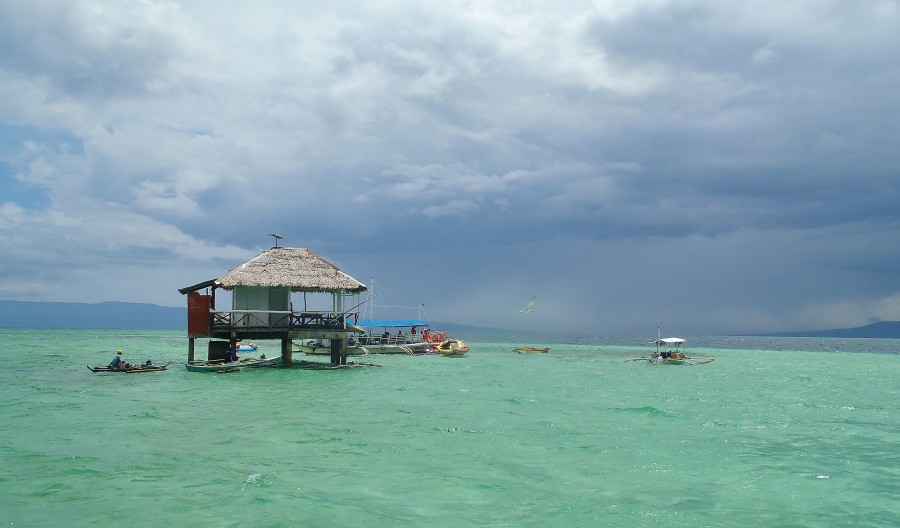
In the Philippines, life also happens at sea. During low tide, sand sticks out of the water, and then there is a bazaar.
After Sipalay, I was heading north, this time to the little Palupandan town from where was only 5 km to the port of Guimaras. Unfortunately, there were no hotels in Palupandan, so I had to stay in the Bago city , located 10 km away (there is also Bago in Burma). Unfortunately there was only one hotel in Bago, for 550 pesos, so I was lucky to spend only one night there. Bago certainly does not charm with its beauty, but there are also good people there, and a good fish and fruit bazaar. It was nice.
The next day I boarded a jeepney and for 10 pesos I went to the bamboo-palm village, proudly described as a port, and then for 95 peso I went by a large wooden boat to the island of mango plantations – Guimaras. The cruise took only 45 minutes.
Guimaras – „the mango island”
As soon as I got off the boat, I immediately saw great views. In front of me there were palm trees and rocks appearing from the sea, on which I entered the island. When the only “polar bear” went ashore in Guimaras, all dark eyes were staring at me. I sat under a wooden hut with a roof of palm leaves and then went to San Miguel town. San Miguel is not interesting, but I stayed there because there is a good hotel in the center, there is good transport, a nice bazaar and a few pubs with billiards. It is good to organize trips from there. The locals were quite funny in the evenings, after having a few drinks.
On my first trip I went to Navalas to see the historic Catholic church, built by the Spaniards in 1880. Navalas however, offered me much more than only the church itself, because the rest of the day I spent on a nice beach with young Filipinos. We talked, then bathed, and on my way back I stopped in McLain, where I ate a good octopus adobo.
Another time I went to the Alobijod beach, where first I swam for a while, and then I went on a boat trip with Filipino tourists. We were on several beautiful islands, where I saw blue lagoons and rock formations – and it was very beautiful. I spent the whole day in beautiful seaside locations, swimming from one lovely beach to the other. When I returned to Alubijod, I sat under a palm tree and ate a delicious grilled fish for a few pesos. I thought I had a good life.
Another time I organized myself tour around Guimaras. First I got to a quiet Clara beach, where I saw fishermen pulling fish from the sea, interesting rock formations and mangrove trees. It was warm and a gentle wind stroked me a whole day.
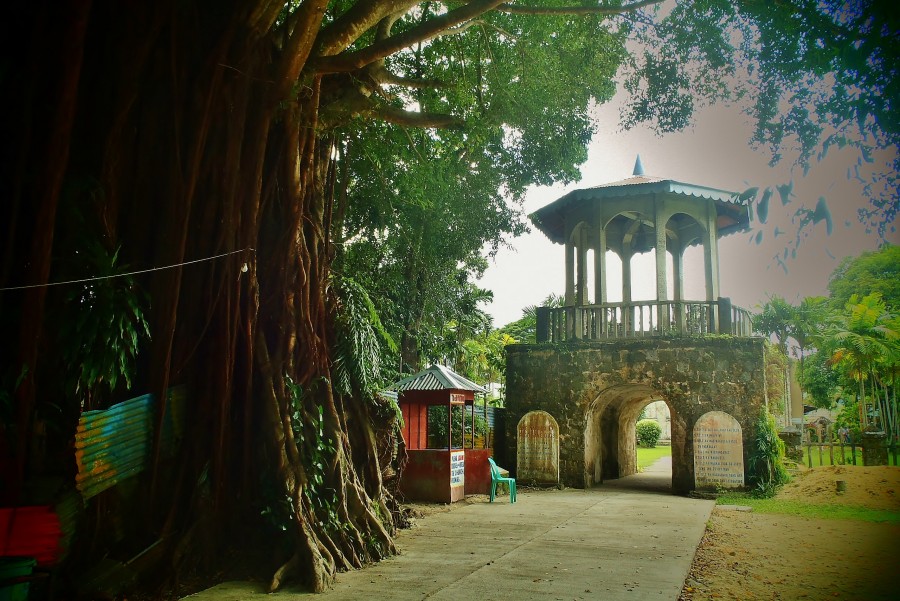
Entrance to the church in Navalas, on the island of Guimaras, Philippines.
Then, on the way back, I stopped by the Cabano village to see huge windmills producing “green” energy. I sat in a bamboo hut under a banana tree, and watched the windmills turning high in the sky, accompanied by a crowing rooster.
I was also in Sebaste, in a holiday resort called Nature’s Trail, where I saw exotic nature, mangrove trees and a quiet beach. After leaving, I came across an armed police, and took pictures with them. From there I went back hitchhiking, sitting at the back of a van. I watched the windmills of the Guimaras island, rice fields and banana trees. The driver dropped me off on the road, near the Cambungahan village, where I spent time with people in their houses covered with palm leaves. When it started to be dark, I was lucky because the motorist who rode to Buenavista stopped, and dropped off at the intersection of roads in the tiny Pina village. It was nice, because in Pina I ate very good boiled mussels, 40 pesos per kilo. Each canteen near rice fields was made of wood, and there were never restaurants but stalls of local fishermen who sold their catches in the evenings.
I think that buying from these people is a very good way of helping the local economy. In the evening someone on the moped gave me a ride to San Miguel for only 100 pesos, and the rest of the day I spent playing pool with Filipinos.
My last day on Guimaras island I went to a mango plantation near San Miguel. Guimaras is famous for its mangoes, and is even called the “mango island”. It is true that in November there is no season for this fruit, but at least I saw the plantation and learned something new. The same day I went to the port by a jeepney and then sailed to Iloilo City on Panay island. The cruise took 15 minutes and cost 15 pesos.
Guimaras island is not prepared for tourists, but I think it is valuable, because it’s an interesting route outside the well known trail of the Philippines.
Panay island
Panay island is not a popular tourist destination, because hurrying tourists usually choose the beaches of Palawan, Cebu and Bohol. I personally didn’t see any Whites on Panay, because this island is mainly treated as an airport, where Whites have to land, to get to the beach paradise of Boracay. I was only in Iloilo City.

Church of St. Anne in Iloilo City.
When I was getting closer to the shore, first I saw dirty barracks and children swimming in the sea. I immediately took the rickshaw and went to the city, to a cheap but a decent hotel for 330 pesos a night. When I was in Iloilo City I had a good time, but it quickly became clear to me that social life is taking place in two main places, near the two great Catholic churches. The first place is the district of Molo, whith its famous St. Anne’s Church. I spent most of the day in the square in front of the church, where many things, there is a basketball court where young people practice dancing, and where there are many street vendors. I invited a young Filipina for a cola to talk to her about her country, and then I tried rice pancakes and coconut cakes.
Interestingly the cookie sellers wanted to give me a Filipino wife, because as they said, “I was rich because I was from Poland.” When traveling in the Philippines, I noticed that many people thought that I came to the Philippines to find a Filipino wife, while others even offered me a woman for a permanent relationship. They suggested me to take a Filipina, sometimes even shouting to me from afar that: “she was single.” In the Philippines, as in other Asian countries there is a legend of a “white millionaire”, who was born in golden shoes and is able to pay an absurdly high prices. Explaining to those people that it is not like that, doesn’t make sense. In many places in the Philippines, I felt like a rock star that everyone was looking at.
I liked the Saint Anne’s Church, and I think that there is a need for one like that London, near Big Ben. Across the street there was also a cultural center, where I visited a picture gallery, and then went to eat tropical fruit. This time it was pomelo from the Mindanao island, reminiscent of grapefruit. On the same day I also went to the Catholic Order of Asilo de Molo, about 1 km from St. Anne’s church. I was guided by a Filipino nun who showed me the church, a meeting room, a garden with a pond and a small plantation of tropical fruits.
In the evening I returned to the St. Annes’s Church, and went to the shopping center, where they offered free massages with the use of a medicinal oil. I ate grilled adobo octopus and returned to the hotel. Whilst in Iloilo City I moved around by jeepneys for 8 pesos, which is fast and cheap. I also traveled to the Lapaz and Jaro districts to see the Jaro Cathedral and the Belfry Tower, built in 1744 and 29 meters high. As I could have expected, there were also sellers of coconut pancakes and drinks, although there were also tropical trees with lianas.

Jaro Cathedral and Belfry Tower; Ililo City, Philippines.
In Iloilo, there were basically two churches and a tower to see, though the people and the port were also interesting. It is definitely worth to go there to have this experience. Soon, I went by jeepney for 8 pesos to the SM City shopping center, and from there I drove to the airport for 70 pesos. Then, I flew to Cebu City.
Cebu City
Cebu City is the second largest city in the Philippines after Manila. There is tiring traffic, pollution and a lot of people. I went to Cebu City at night, and I immediately took a taxi for 300 pesos and drove to Downtown, where most of the cheap hotels are located. I ended up paying 450 pesos, and another 400 pesos for a hotel per night. The taxi driver started an interesting topic with me. Well, he offered me “girly bars” – or brothels to be exact, because in his opinion White men come to the Philippines not for nice beaches, waterfalls or for the culture of the Philippines, but just to the brothels. Such opinion about White men often come out in conversation with the Filipinos.
Cebu City is more expensive than other, smaller cities. In Cebu City I had a few places to see, although I knew that on that occasion I would not have enough time to see the whole island. My two-month visa expired, and that’s why I went to the immigration office to buy a new one, but unfortunately the visa prices were so expensive that I decided to only see Cebu City and its immediate surroundings For that reason I made a decision that instead of paying for the extremely expensive Philippine visa extension, it would be better to fly to Brunei, and then I continue my journey around Borneo, but only in the state of Sabah. On my back to the Philippines I would land in Mactan – Cebu City, and I get a monthly Filipino visa for free. That was enough for me.

The Santo Nino Cathedral in Cebu City, Philippines.
Most of my time in Cebu City I spent in the Downtown district, because it is the area of the biggest interests to tourists, with many sights and street stalls. Downtown gives a better opportunity to get to know the people and the character of the city. Cebu City looks like a big outdoor shop, consisting of stalls with grilled meats, fruit, drinks, mussels and phone repairs. There are also shopping centers and massage salons; and road traffic, where iconic jeepneys attracts attention. I walked around the city for a few days, I talked to people and had a few meals, watching hurrying Filipinos.
The symbol of Cebu City is Santo Nino – the oldest Catholic cathedral in the Philippines,which was built in 1521, as a gift to the Philippines from the Portuguese explorer and discoverer Ferdinand Magellan. In the temple complex there is a nice church with many paintings depicting Christian saints, and just before it a ceremonial square, and a very secluded place for lighting candles. Inside, there is also a square with a fountain and vegetation, and a wooden figurine of a child Jesus behind a bulletproof glass. The Santo Nino Cathedral is very atmospheric and quiet, and in my opinion it is the most pleasant and the most culturally valuable place in Cebu City. I went there many, many times.
Just behind the Santo Nino Cathedral there is the Magellan Cross, set by the Spanish and Portuguese explorers, on the orders of Ferdinand Magellan, on March 21st 1521, when they arrived in Cebu. The cross is located in the chapel, and on the ceiling there are frescoes depicting explorers from Iberia. This place is also very popular, both among tourists and souvenir sellers.
Not far from the Santo Nino Cathedral and the Magellan Cross, there is Fort San Pedro, built by the Spaniards. Fort San Pedro is a defensive fortification, which construction began in 1565, and then the works were postponed for another two centuries. It is not entirely clear when it was completed, although it shows 1738 on the main gate, and the renovation took place in the 19th century. Fort San Pedro is located on a triangular area, and it has been used by various occupying armies for many purposes for centuries. The fort served as a place for the army, as a hospital, and even as a zoo. Today however, it is a very pleasant place built of stones, with there are defensive walls, cannons and exotic vegetation. Fort San Pedro has a dark past because it saw many wars and a lot of blood, but today it is a very pleasant, relaxing place that should be included on the list of everyone who visits Cebu City. A pretty Filipina guided me around the facility, what was also a great asset of my visit.

Philippine beauty.
My last place on that day was the Carbon Market, a very dirty and chaotic bazaar where one could buy everything from fruit and meat to shoes and shaving utensils. I recommend the Carbon Market especially to those travelers who want to know the realism of the Philippines. It’s poor and dirty, but memories are definitely worth it. This place definitely has its charm.
Apart from that I stayed in Cebu City for a long time. I tried street food, I had a few massages, and I left luggage there when I left for Borneo, and when I traveled north and south of the Cebu island. I was also in Uptown many times, which is the a newer and the better part of Cebu City. The central point is the round green area called Feunte Osmena, popular with frequent concerts and food stands.
Every time I was there, I always wondered why there was never any water in the fountain???
Trips outside of Cebu City
I went for a one-day trip outside Cebu City to see two places. The first, very attractive object was the Chinese Taoist Temple, completed in 1972 and funded by the Chinese community of Cebu. It is located in the Beverly Hills area of Cebu, and was built on several levels. Like every Chinese temple, this one is also very attractive because it had buildings with colourful, profiled roofs, with dragons, Chinese alphabet, a pool with turtles, and even a replica of the Chinese Wall. The entire Chinese temple complex is very moody and I warmly recommend it to everyone, as an interesting cultural experience.

In the Taoist Temple outside Cebu City.
Then, after a meal at a roadside bar, where I was served grilled sweet bananas, I rode on the back of a moped to the top of the highest point of the Cebu island, to see the Temple of Leah, still under construction. Temple of Leah is built in Roman style, as an act of love worth 80 million pesos, in honour of the owner’s wife of this building, Leah Albino-Adarna. The building has 7 floors, statues of lions, many sculptures and columns, and a style characteristic of the Roman Empire. Inside there are Leah’s memorabilia, such as books and antiques. In the main hall there are stairs leading to opposite directions, while in the center stands a golden statue of Leah, with an altar on the back wall.
Temple of Leah offers nice views of Cebu City and thanks to it tourists can move back to the Roman times. In my opinion, to tourists it is a building of smaller importance, because it was built in 2012, in remembrance of a person who hardly anyone heard of.
On my last day in Cebu City I was preparing to leave the Philippines after almost two months of travelling. Even so, I still had time to go for a massage, and then I rushed by taxi and stood in traffic. Soon I flew to the Sultanate of Brunei.
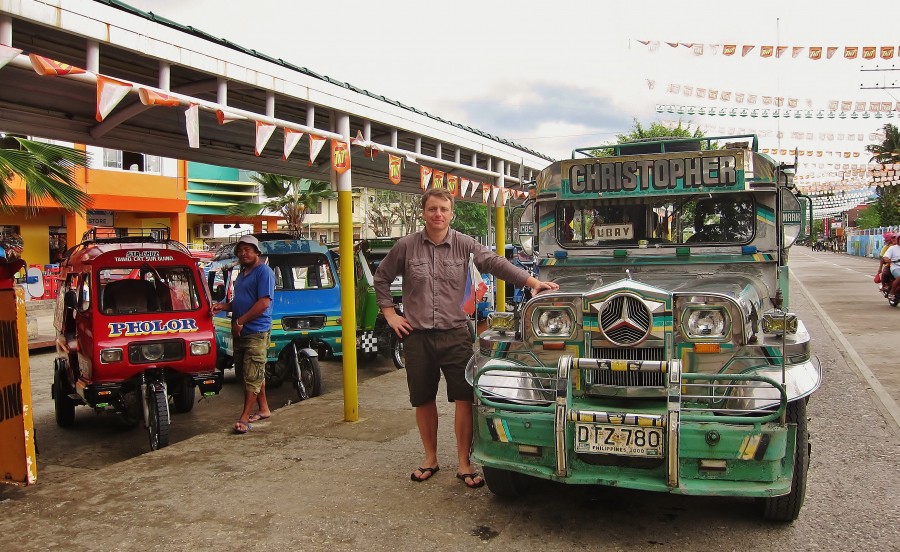
When in the Philippines I travelled high class; most often on a board of jeepney.
The Sultanate of Brunei
Last time I was in Brunei in 2012, but only for a few days and only in the capital Bandar Seri Begawan. In 2018 I was just traveling in the Philippines, and at some point my two-month visa was close to expire, and the new one in the Philippines cost a lot of money. For that reason I thought that it would be better if I take the cheapest flight to Brunei, I would spend there for a few days and then go back to the Philippines, where I would get a free visa for 1 month. My visa trip to Brunei turned out to be an extraordinary adventure, because I stayed in Brunei for 8 days, even though I was planning to stay 4 days the longest. After Brunei I organized an expedition to the Malaysian state of Sabah in Borneo, which took me about a month.
My return to the Philippines for a free visa took me much longer than I planned, but it was irrelevant to me, because I had a wonderful adventure at the end of the world.
Southeast Asia has a lot more to offer than just one Thailand. Traveling in this region of Asia is also a culinary journey among the interesting nations of many cultures.

Omar Ali Saifuddin mosque in Bandar Seri Begawan (BSB).
Brunei is an underrated country, often called a „boring oil-rich Muslim state”. It is true that not a lot is going on in Brunei, and that the country’s economy is based on oil. However, Brunei has an attractive small capital Bandar Seri Begawan (BSB), the largest village on water Kampong Ayer, and it also has a river and mangrove forests, with residents such as proboscis monkeys and crocodiles.
Things to see in Brunei
Brunei also has a tropical forest in the Temburong exclave, nice beaches, good Malay and Indian food, good shopping and interesting museums. Therefore, I do not agree that there is apparently „nothing to see” in this quiet, peaceful country, and it is certainly not boring. On the other hand, Brunei is not famous for parties too, and it is not allowed to drink alcohol, but it certainly deserves a few days of any traveller’s time. Compared to 2012, when I was in Brunei for the last time, several things have changed for better. In the BSB for example, there is a new Ecopark; a nice bridge over the river, decorated with baoab trees from Madagascar, and with a view of the Omar Ali Saifuddin mosque and Yayasan Complex. I recommend this place for shopping and meals on the top floor.

Panoramic photo of Ecopark in Bandar Seri Begawan. In the center we can see the Omar Ali Saifuddin mosque, and Yayasan Complex on the right.
Whilst in Brunei, the same as before I have my base in Bandar Seri Begawan, and from there I organize trips to the further parts of the country. In BSB I went again to the Sultan’s Royal Regalia Museum, I went to see the Sultan’s palace Istana Nurul Iman, and I tried the Malay and Indian specialties at many restaurants and street stands in the BSB. The people of Brunei are nice, calm and helpful. For example, hitchhiking works quite well, and it is not expensive at all. At least it was cheap for me. In Bandar Seri Begawan I also went on a boat trip to see proboscis monkeys in the mangrove forest, the water village Kampong Ayer and the panorama of BSB seen from the river.

The Sultanate of Brunei is more than just mosques and the oil industry. I took this picture in the Ulu Temburong National Park, where there is a jungle, a waterfall and a beautiful adventure close to the nature.
My first trip outside BSB was to the exclave of Brunei, Temburong, where the Ulu Temburong National Park is located. Although Brunei is mainly associated with Islam and mosques, to me Brunei is mainly about walking in the primary rain forest, with trails through the jungle and with proboscis monkeys, which live in Brunei in large numbers.
When in the Temburong jungle, I saw a river in the colour of tea with milk, which I crossed on a board of a long wooden boat. Finally, we moored along the trail, which led me several kilometers to the platform at a height of 200m above the ground, from where I saw a vast panorama of the Temburong jungle. I was very lucky because I managed to notice a pair of flying hornbills, which is one of the symbols of the island of Borneo.
On the way back we did rafting on the pontoons down the rapid river, and I swam in a natural pool by the waterfall. This is Brunei! Beautiful and adventurous, though I never have enough adventures, that’s why I stayed longer in Temburong to climb the Bukit Patoi peak in Peradayan Park. The next day, in the evening I returned by motorboat through the Malaysian territorial waters to BSB, which took me about 45 minutes.
(By the way, The Sultan Brunei is building a 30km bridge connecting the main part of Brunei with its capital Bandar Seri Begawan – with Temburong, and its construction is to be completed by the end of 2019).
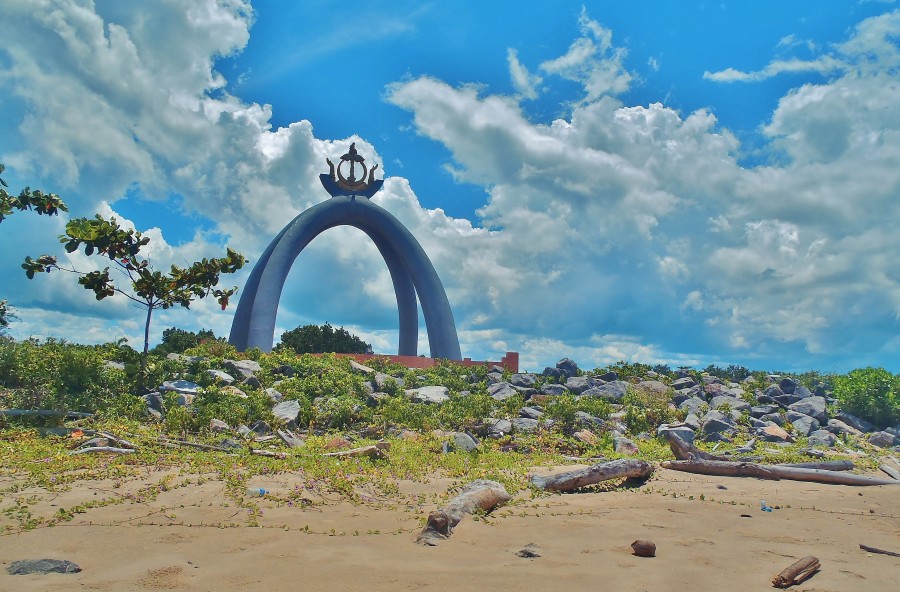
The Billionth Barrel of Oil monument seen from the beach in Seria.
Apart from that I went to the Jerudong Park, and later to the famous monument of money – to the Empire Hotel. The Empire Hotel is a gold-dripping building complex, located amidst beautiful nature. I swam in the pool, then on a private beach. Then I hitchhiked to Tutong, a small town near a nice beach. Brunei has quite a few nice beaches, some of which are suitable for windsurfing because of high waves. Other nice beaches were near the port town of Muara. One was huge, long and wide, but the other was small and I don’t advise anyone to swim over there because of the company of crocodiles. I also liked Seria town, colonized by the British Shell oil industry; with its monument of the Billionth Barrel of Oil, very interesting factories, oil pumping machines and a museum. I however spent most of my time on the beach.
(By the way, I think that the management of Shell should get a kick in the snout, because the water in Seria is brown and smelly, while in Tutong and Muara located about 40 km away, the water is clean and blue. It is therefore obvious, who in Brunei is the biggest, and the smelliest pig. Of course, the British Shell.)
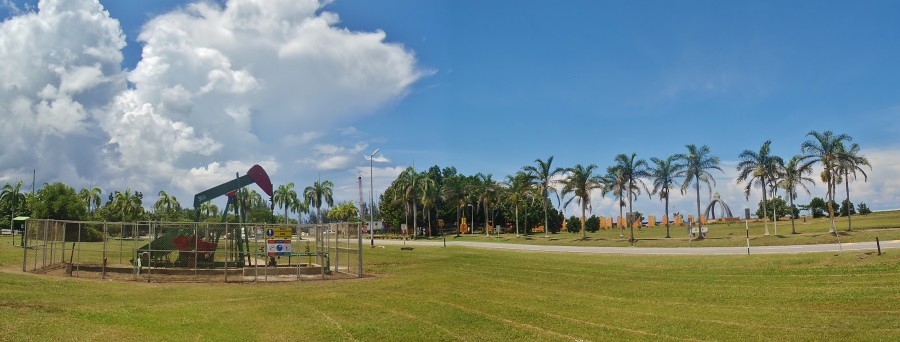
I visited the town of Seria, which has been colonized by the British oil company Shell. On the left we can see oil pumping machines, and on the right, behind the palm tress, the Billionth Barrel of Oil monument, built to commemorate the extraction of a billionth barrel.
In short, these are the most important places that I have seen in Brunei, and I am happy that I have visited this country again. Life in Brunei is peaceful, well-organized and there are enough attractions to keep travellers busy for a few days. I left Brunei by boat from the port of Serasa, near Muara.
Within 1h and for a magical amount of B$17 I got to the Malaysian island of Labuan, where I already spent a few beautiful days few years ago. Transport by boat from Brunei to Labuan is by the way the only type of transport that I advise to people going to Sabah.
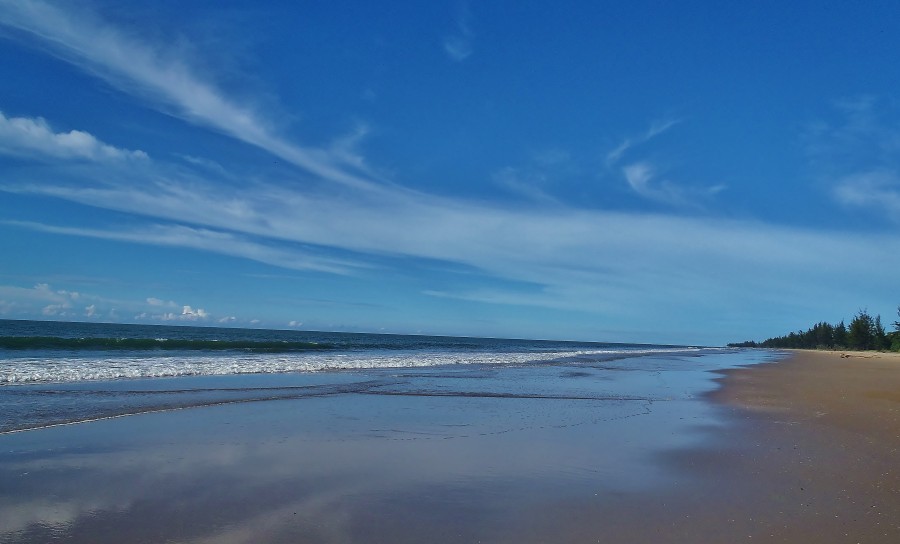
Tutong is yet another very interesting place in Brunei, where one can try Malay and Indian food, or fish around the mangrove forest, or buy a camera. 2km from Tutong there is one of the most beautiful beaches of Brunei, although those who are really thirsty can also knock on the British military base front door and ask for a cup of tea.
Departure to Malaysia from the Serasa port
From the bus station in BSB I went to Muara by bus no 38, but I left a few meters before the town. From there I hitchhiked to the port of Serasa, from where by a fast motorboat I sailed to the island of Labuan. The journey took me 1h and cost $17.
! If someone goes from Brunei to Miri in the Malaysian state of Sarawak, I recommend taking a bus from BSB or Kuala Belait. However, travelers traveling to Kota Kinabalu in the Malaysian state of Sabah should go by boat, and change on the island of Labuan. I think it is the best way. Of course, one can also go by bus, but due to the many border controls I do not recommend this method.
Malaysia
I’ve been to Malaysia several times, both the western and the eastern. I’ve already been to Kuala Lumpur, on the island of Penang and the Perhentians, and I also crossed the tea fields in the Cameron highlands. On the other side of Malaysia, in the Malaysian Borneo, I got to know well the Sarawak national parks. Among the many beautiful places, in 2012 I was also in Bako Park, Lambir Hills, and I saw the Niah caves. To the full happiness of my Malaysian adventure I only missed the Sabah state, and that is why in 2018 my plan was to organize an expedition from Kota Kinabalu to the Semporna Archipelago.
However, considering that I had been to Brunei, first I had to have a stop-over again on the Labuan island.
Return to the Labuan island after 6 years
I already went to the Labuan island in 2012, during exactly the same route. I was traveling from Brunei to Kota Kinabalu in the state of Sabah, that’s why Labuan was an obvious stop-over. One can also get a bus from Brunei to KK, but it takes a long time and there are a lot of checkpoints along the way. Labuan is therefore a very convenient place for a stopover …. which took me almost three days. I was also curious about what has changed in 6 years, and I must admit that Labuan has been improved quite well. Where there used to be just a few houses, today there is a new town and a bus station, and where there was only a beach and a clock tower in 2012, today there is a street market and shopping centers. There is no doubt that Malaysia is developing at a rapid pace. My aim this time was to make my trip to Labuan much better than the last time.

A view of Victoria from a boat, the capital of the island of Labuan, while getting to the shore.
I describe Labuan island as a separate territory of Malaysia, because it is a very specific island. Labuan forms one area with six other, very small islands. Despite its location, Labuan is neither part of Sabah nor Sarawak. Labuan is a federal territory administered directly by the government in Kuala Lumpur, but located off the coast of Borneo, near the state of Sarawak and Brueni.
Labuan Island, which is a duty-free zone, has very favorable economic conditions and transport routes. There is an airport and a harbour here, from which travellers can get to many parts of Malaysia and Brunei. When approaching Labuan by boat, I saw that the presence of oil and gas industries, and there is also a shipyard on the island where ships are built. The small Labuan, covering 92 km² and with a population of around 100.000, is a small financial and energy center serving the entire Asia-Pacific region. To businessmen who wish to do business in Asia, I advise to get interested in Labuan and register their businesses there. For sure it would be easier, and such exercise would save money.
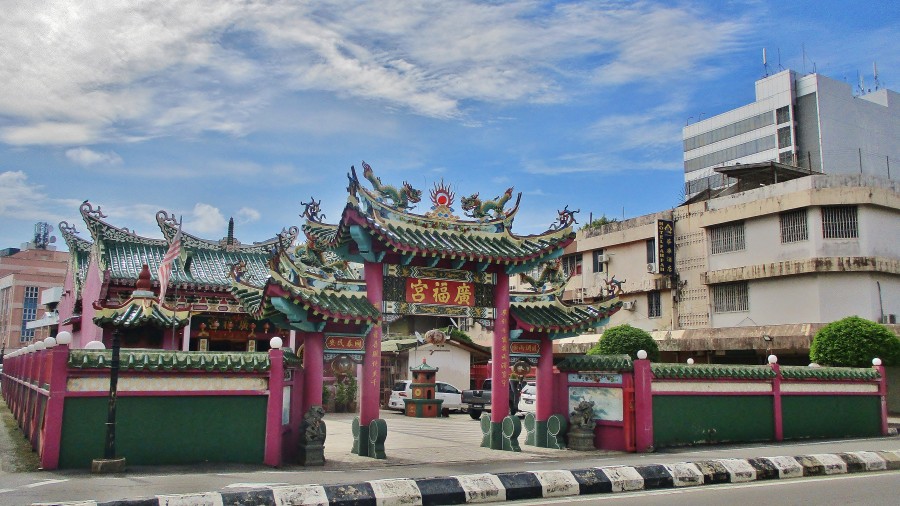
Chinese temple in Labuan.
In addition, Labuan is also a popular island among the residents of Brunei and Miri (Sarawak) and Kota Kinabalu (Sabah). Labuan is also visited by foreign guests, and even from countries as beautiful as Poland. Of course, I would be bored to death if I had to look at shipbuilding factories or oil barrels, that’s why luckily there are also beautiful and interesting places to see in Labuan.
After leaving the port in Victoria, I looked around and didn’t recognize the place, which I thought I remember so well from 6 years ago. A new, renovated small town was right in front of me, and the port building was also new. First, I sat in a Chinese restaurant and had a Chinese style chicken, and then walked along small streets looking for a hotel. Finally, near the Chinese temple and the bus station, between the row of shops I found a hostel where I paid 30 RM for a small room with a ceiling fan. It was a nice neighborhood.
Next to it there was a village on water, built on wooden posts, well-stocked restaurants and shops, and an impressive Chinese temple decorated with dragons. There was also a channel nearby, where I was able to see a large monitor lizard, which then I saw every now and then. In the evening, Malaysians would set up their stands and sell drinks, desserts and other Asian specialties, often with the use of coconuts.

The Chimney Museum and the Chimney Tower in Labuan island.
Things to see in Labuan island
Whilst in Labuan I took a few trips. The first one was on aboard of bus number 6 from the bus station, to the Chimney Museum, next to the Bird Park. The Chimney Museum was an interesting, small museum showing the history of coal mining in Labuan in the years 1847-1911. In the former school, on two floors, there is a history of coal mining, and at the bottom an interesting exhibition showing the underground corridor and people at work. An important part of the museum is the Chimney Tower, which is a historical landmark and a remnant of the coal mining era in Labuan, initiated by the British. More information about the Chimney Museum can be found at http://www.jmm.gov.my/en/museum/chimney-museum
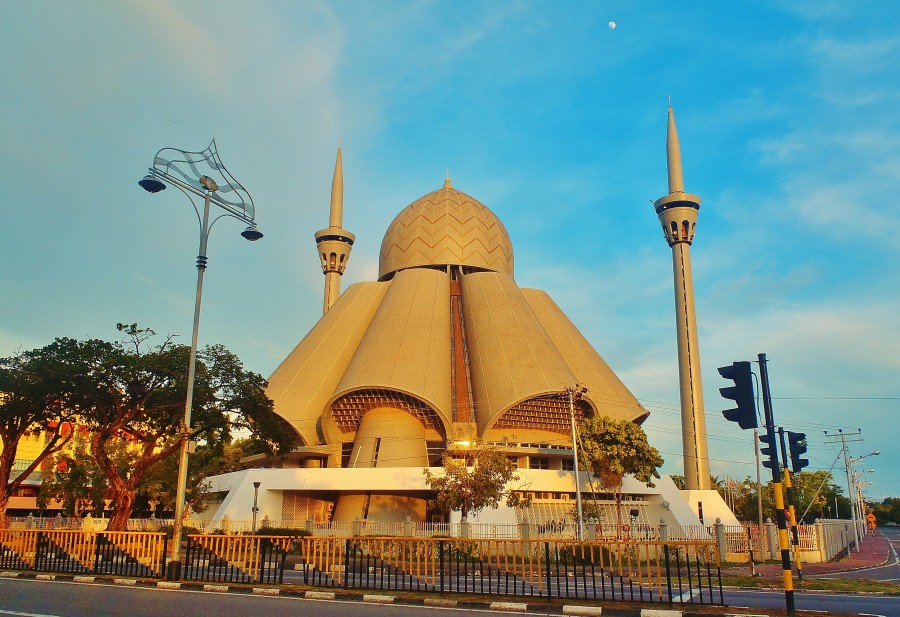
Mosque from “Star Wars” on the island of Labuan. It looks as if it was getting ready to take off into space.
A few steps away from the museum there is the Bird Park, where I spent a very nice time watching many species of birds endemic to the island of Borneo, and which can be seen only in the deep jungles of Sarawak and Sabah. Among many great birds I saw hornbills, cockatoo, kingfishers, peacocks and my favourite – crowned cranes. Majestic, elegant birds, though very territorial. When the female was sitting on eggs in the nest, the male behaved aggressively. He spread his wings, opened his beak and attacked me. The crowned cranes were without a doubt the most beautiful, although hornbills were also a pleasure to watch. One of them always came to me when I was whistling at him.
The Bird Park is in my opinion an obligatory place in the Labuan island, because in the area of almost 7 hectares there are many huge aviaries with exotic birds. Let’s remember that for contact with the nature no-one is ever too young or too old, and also never too serious. The entrance is cheap. I only paid only 5RM. http://labuan.attractionsinmalaysia.com/Labuan-Bird-Park.php
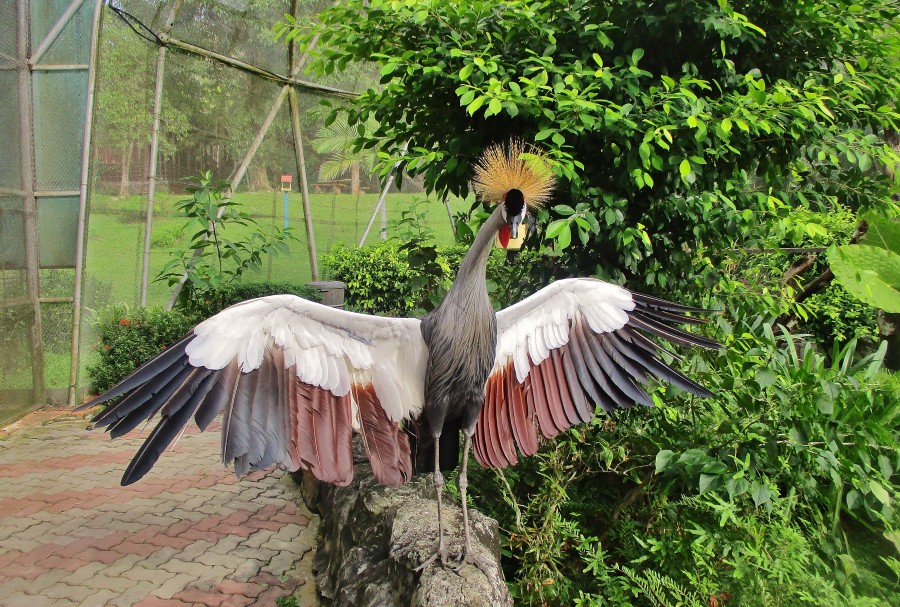
A crowned crane in a fighting position, in the Bird Park on the island of Labuan.
I returned to the center of Labuan hitchhiking, on the way getting off in front of a mosque, which looked like a warship from Star Wars. In my opinion, it looked like a Darth Vader’s helmet, and its 2 minarets looked like lasers from the Impere Strikes Back. Then I walked around the streets of Labuan, stopping at street stalls with food. Also, young Malaysians from the University of Kuala Lumpur interviewed me about what I though about Malaysia and Labuan. Well, I think about their beautiful country in a very good way. The only thing I do not like are palm oil trees, because orangutans lose their jungles because of them.
On my last day I went to the Peace Park, by the sea. The Peace Park has a historical value, because there is a monument there built by the Japanese, who in that way wanted to apologize and express the desire for peace between Japan and Malaysia. The whole of Borneo was occupied by Japan, and whilst travelling around Borneo I saw many monuments commemorating the Japanese surrender to the Australian troops. A similar place, but much bigger, I saw a few weeks later in Sandakan. http://labuan.attractionsinmalaysia.com/Peace-Park.php
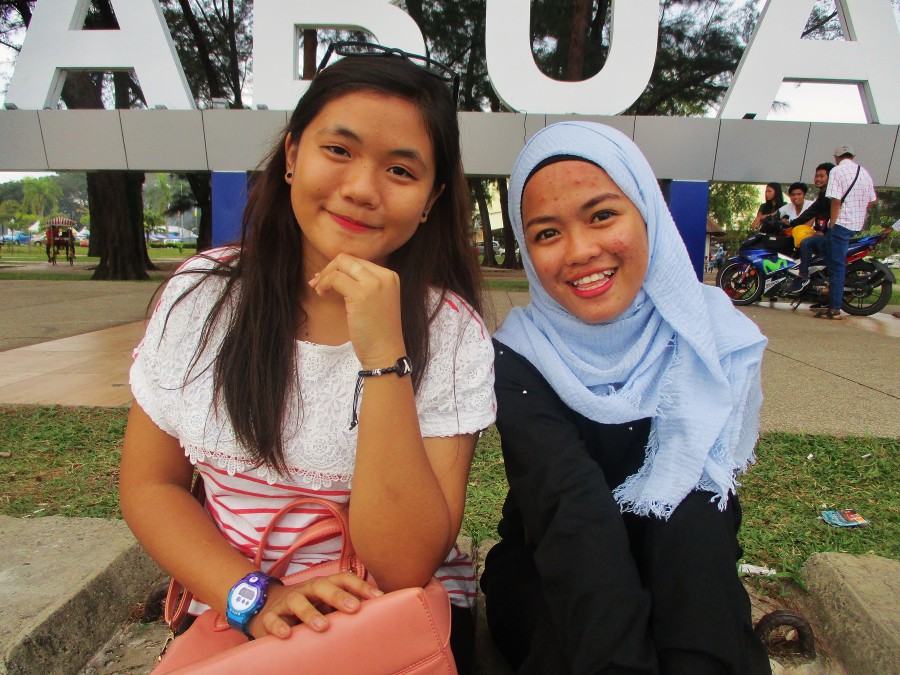
Muslim girls on the beach in Labuan.
However, to not make it so sad I would like to add that after the Peace Park I went to the beach, where I walked on white sand, I swam in the sea, and then I enjoyed a delicious Malay dinner under big trees, which huge roots served as benches. Whilst eating grilled chicken wings and sipping a coconut, I thought about how good it was for me in Labuan. It rarely happens that I return to the same place twice, but this time it was worth it.
In the evening I went to the beach near the clock tower, where 6 years ago stood only this tower in the green field. Today however, this place is full of life. There are bazaars, shopping centers, street vendors and children on roller skates, riding along the promenade. It also occurred to me that if the British Empire was really so bad, then why are these people so happy, why trade and industry blossom in Labuan, and why there are monuments in the honour of the Australian army? I would like to ask this question to the promoters of White Guilt in England.
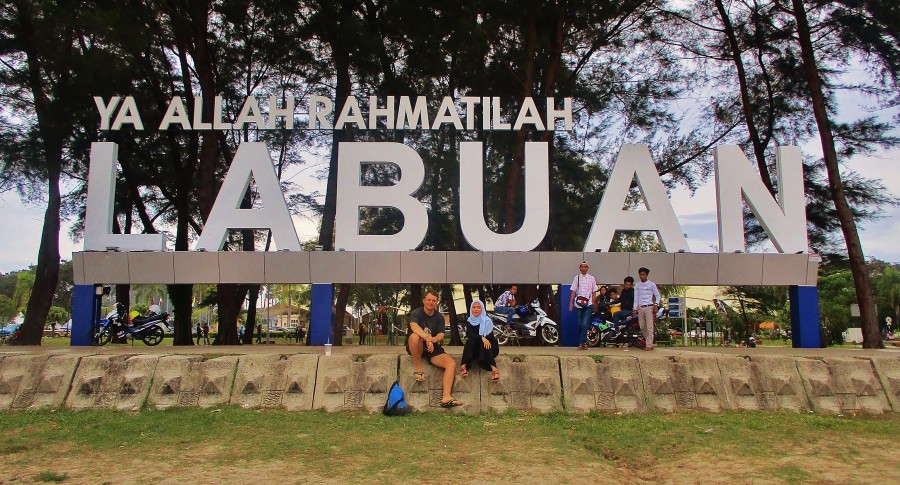
On the Labuan beach.
I spent my last evening calmly, tasting Malay and Indian delicacies, and strolling by the sea where I talked to fishermen. The next morning, I looked again at the water village, I looked at the Chinese temple and the big lizards in the canal, and I went to the port. I went to Kota Kinabalu, which cost me 39RM and it took 3.15h.
Sabah – the Malaysian Borneo
Destination Borneo
I’ve planning my next trip to Borneo for 6 years, when I was here for the last time in 2012. I wanted to return to Borneo, specifically to the state of Sabah, because last time it was the only part of Malaysia which I haven’t explored yet. In 2012 I travelled for many months around the Western Malaysia (peninsular), and then I ended up in Kuching, where I started my journey through the state of Sarawak. It is true that I finished my journey in Kota Kinabalu, but at that time I didn’t go any further, but then I have not yet travelled through the state of Sabah.
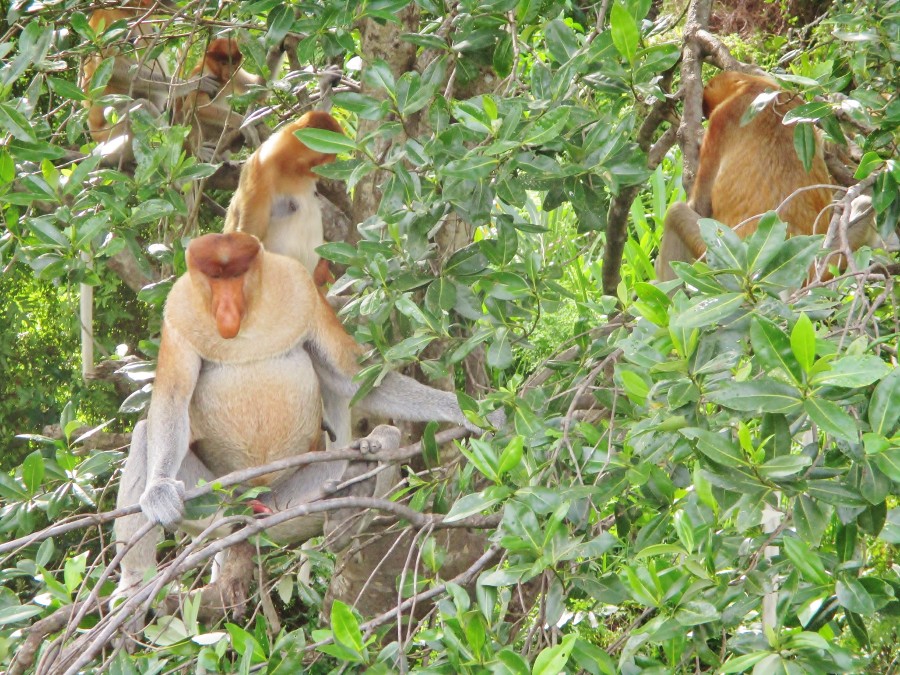
Proboscis monkey – one of the symbols of Borneo.
Malaysia is undoubtedly a beautiful country, rich in natural beauty and the peculiarities of nature. I found that out when I was in the Taman Negara Park and in Sarawak parks, such as Mulu, Niah and Gunung Gading. I saw big caves, primary tropical forests and wonderful Orangatans. However, the nature Borneo is not everything, because Sarawak is also worth a visit due to the culture of the people of Borneo. In the cultural villages, I saw how people lived in a traditional way and how they make food. I saw their costumes and national customs – and I think that cultures and traditions should be preserved.
This time I wanted to concentrate all my energy on the state of Sabah. I knew that I would see Orangutans and proboscis monkeys, but each state is a little different and has something new to offer. Also, the fact that I haven’t been to Sabah so far, has been a burden of my traveller’s ambition. I intended to have fun, but above all I wanted to enjoy the nature of the island of Borneo. Whilst raveling around Sabah, I saw many places and had many interesting adventures, but in this article I will only tell briefly about the most important ones. I appreciated the very important things a traveller should see. I enjoyed street bazaars with exotic fruits, fish restaurants in the seaports, cultural villages of Borneo people, and of course the beautiful flora and fauna of Borneo.
Generally about Kota Kinabalu
My first place was the main city in the state of Sabah – Kota Kinabalu. I’ve been there before, but this time it was a bit different. Kota Kinabalu was more developed, there were more stores, more goods and more money to spend. However, the charm of this seaside city remained the same. Bazaars and fish restaurants by the sea, exotic fruits and a nice climate of Kota Kinabalu kept me there much longer than I planned. Simple things which seem to be boring for Malaysians, to white tourists were interesting, beautiful and valuable. In my many reports I have already made it clear that the beauty of the world is based on differences.

With the flag of Malaysia in Kota Kinabalu. Sabah, East Malaysia.
!!! I got wet a few times during the rainy season, but it was a warm tropical rain, so it was nice. I also liked Borneo tea and coffee with a durian flavour. I would like to say that tea in Malaysia is harvested by Orangutans and long-nosed monkeys, but I don’t expect anyone to believe me in that.
Kota Kinabalu was also my base for some time to the places of interest. I think that every visit to Kota Kinabalu can be also treated as a culinary trip.
Places of Interest in Kota Kinabalu and its surroundings
It is worth mentioning that although the city of Kota Kinabalu offers many attractions and it is full of interesting places for travellers, many places of interest are located outside the city. I advise travellers to not to be lazy and go out of Kota Kinabalu.
The State Mosque
The State Mosque is an impressive Muslim temple, which strikes with its size, and is further away from the loud centre of the KK. The mosque has a large golden dome, a golden minaret and several small minarets with golden tops. Inside, there is a prayer room and an attractive pond. The whole object is located inexotic nature, that’s why I recommend it to all travelers as an interesting cultural experience. On the other hand however, I whole heartedly wish Muslims to stay in Malaysia and build mosques in their countries.
The Sabah Museum
Near the State Mosque there is Sabah Museum, which is an ethnographic museum and the Sabah natural history museum under one roof. Among many things, the museum houses a whale skeleton, wedding dresses and ceramics found the state of Sabah. I saw models of traditional Borneo houses, with precious finds and costumes of the indigenous people of Borneo. Borneo animals such as the Pygmy elephant, Sumatran rhinoceros and sea turtle, I also found to be very interesting expositions. I think that Sabah Museum is very important to those people, who want to ge to know the culture and the history of Borneo, instead of just seeing Orangutans and leave.
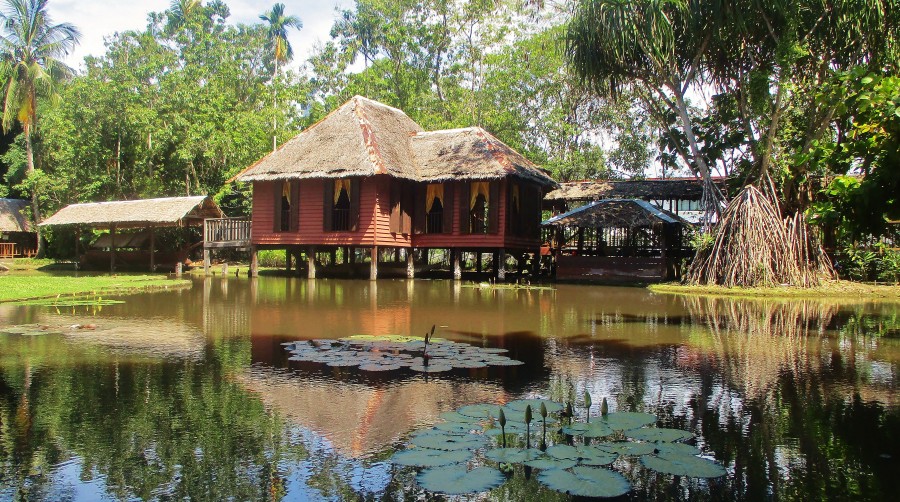
Cultural village at the Sabah Museum in Kota Kinabalu.
The second building is Sabah Art Gallery where there are several interesting paintings and sculptures created by artists from Sabah. I recommend! There is also the Centre for Arts and Education, which has exhibitions on oil extraction, from drilling to processing to petrol. I had seen similar museums before in Miri(Sarawak), and in Brunei. Museum facilities are located on a large area, and their architecture is modelledon traditional Borneo longhouses, from Rungus and Murut tribes.
Below, there is the Cultural Village, which gives a chance to get to know the traditional wooden houses of Borneo, built around a pond. The whole area is also surrounded by tall bamboos and has a bridge on ropes. The Cultural Village is a very peaceful and a culturally valuable place.
My critics do not want to understand that I love other cultures, and it cost me a lot of effort to get to know them. I just don’t want the whole world to live in one place at the expense of the native culture, under the Communist regime.
The Musem of Islamic Civilization
An interesting place in Kota Kinabalu was also the Museum of Islamic Civilization. What I liked the most about it, was the so-called ‘map of Islam’, showing all Muslim countries and all the countries with large Muslim populations. There were selected countries, such as: Saudi Arabia, Indonesia, Pakistan and Bangladesh, but on the other hand; very rightly but tragically, some of the selected countries included: England, France, the Netherlands, Sweden and Canada. In the background there were shown smiling women and children, but there wasn’t a single word about Muslims organizing terrorist attacks, burn churches, and raping White women and children.
After leaving the Museum of Islamic Civilization someone could have the impression that Islam in Europe is a salvation to us, and that Muslims are our friends. I remember that similar lies I saw in the fraudulent Stalin’s Museum in Gori. Over there it was also possible to get the impression that Stalin was a “good uncle” and that Communism was “an economic miracle and the oasis of freedom.” Muslims are experts at whitewashing their ideology, and the crimes of their pseudo-prophet. Today’s Muslims; some good, somebad, in my opinion are going the wrong way. I believe that alongside the Koran, it is necessary to introduce the philosophy of ancient Greeks in the Muslim countries, so that they could decide for themselves what they prefer.

City mosque, or so-called mosque on the water, about 4km from Kota Kinabalu.
However, I would like to add that people of Borneo I consider to be nice and helpful, and I have good opinion about them. My bad opinion about Muslims in Europe and my strong right-wing views do not apply to Muslims in their own countries. To be fair with Muslims, I disagree with all the wars in their countries and I think that the West, which is financed and ruled by the Zionists did a lot of evil in the Muslim countries.
Every war in the Middle East and the mass immigration of Muslims to Europe stinks to me with Zionism.
Kota Kinabalu mosque (“the floating mosque”)
Officially named Masjid Bandaraya Kota Kinabalu proved to be one of my most enjoyable experiences in this city, and I liked the whole place so much, that I did this trip twice. From the centre, which is from from the area of the Blue Merlin monument, all the way to the floating mosque I walked about 4 km along the seashore. It was a warm tropical day with random showers, which is why I was not in a hurry. When I got to the point where I saw the mosque, first I went to a nearby beach to eat a Malay dinner, drink Malaysian tea “teh tarik”, and swim without crocodiles, as I had done before in Brunei. I spent the whole day on the beach, among the trees, and I was sipping Malaysian tea.
It was so nice that I forgot about the mosque. After all, there are so many of them in Londonistan – more than in Islamabad, more than in Amman and in Beirut, more than in Mecca !!! (Holy f**k!) …
I went back to Kota Kinabalu using the same way, and I spent the evening at the fruit bazaar. The next day however I finally wanted to see the famous mosque on the water, so this time it was my priority. The mosque was completed in 2002 and it cost as much as 34 million Malaysian Ringgit. It has 4 minarets, and a huge main dome in gold and blue. In addition, there are 3 Muslim schools (madressas), its own clinic, and a main praying hall for 12.000 worshipers. The greatest charm of this mosque is in placing it on the edge of a large pond, which gives it a special, picturesque character, and gives more sophisticated photographic possibilities.
In addition, around the mosque there are bars with food and drinks, Muslims listen to music and it is generally a fun place. I was also given a tour around the mosque by young Muslim women, who were very curious where I was from, and why I visited Malaysia. Those sweet Muslim kittens were greatly impressed by my travels to Muslim countries. I paid 5 RM for entry, and I remind everyone that because it is a place of worship, tourists should dress appropriately.
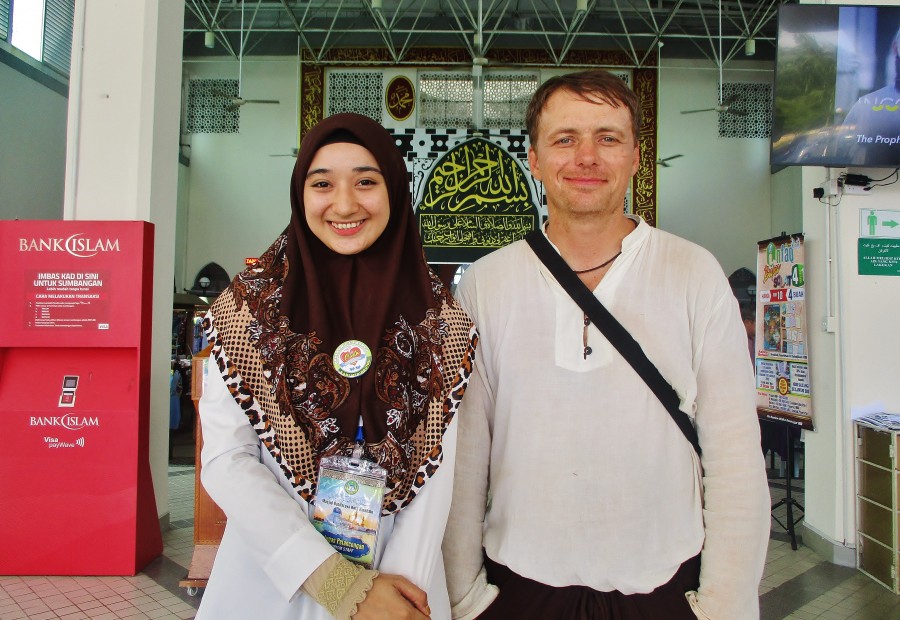
This nice Muslim girl showed me around the mosque. As my readers see, she was happy because she met a goodhearted man.
After the mosque, of course, I returned to the beach, where I spent the rest of the day.
In my travel career, I have seen the best and the most valuable Muslim objects. I especially recommend Iran and Uzbekistan. I admit that I like mosques and I like visiting them when I’m in Asia, but Ijust do not like mosques in Europe, because it is the wrong place for them.
Tunku Abdul Rahman Marine National Park
The first trip I took was to the Tunku Abdul Rahman marine national park. It is a picturesque area at sea, and the main attraction are five exotic islands with white beaches and palm trees. They are: Sapi, Manukan, Mamutik, Suluk and Gaya. All the islands are a bit different, because some have better beaches, and other have better coral reefs around than the others. For example, on the island of Sapi I liked wild monitor lizards very much, and the wooden jetties leading to the beaches. There were nice views from them, although I used them for jumping into the blue, transparent water.
The Tunku Abdul Raman Maritime National Park is a pleasant escape from the noise of the city. The park covers only an area of 49 km² and is made of 5 exotic islands, full of plants, nice beaches with clean water and coral reefs. Every year, this fairy-tale exotic archipelago is visited by about 300.000 tourists, which is why I think it is a must-visit.
Transport by boat to the islands is easily reachable from the Jesselton Point, and the price of transport per one island costs 23 RM at the end of 2018. For two, three and four islands it is respectively, 33, 43 and 53 Malaysian Ringgit.

Tunku Abdul Rahman National Park.
The Lok Kawi Nature Park
I also took a huge hitchhiking trip to the Lok Kawi Nature Park, where among many animals I sawOrangutans, proboscis monkeys, black bears, turtles, monitor lizards and buffaloes. I also saw endemic birds of Borneo, such as hornbills. I liked the beautiful botanical garden in the park, where there were many endemic plants from the Borneo island. Unfortunately, the disadvantage of the park is that it lies off the beaten track; although for a hitchhiker like me, it was not a problem. Getting there by a private car took me about an hour.
Lok Kawi Park is a popular meeting place for families, but unfortunately nobody should expect animals running around freely. It is a very pleasant, well-organized and a clean zoo. Among many animals I sawtigers, interesting buffaloes with large horns and elephants. I think that my favourite ones were Orangutans and the long-nosed monkeys (nasalis larvatus), which are symbols of the island of Borneo. Unfortunately, I was disappointed with the small presence of reptiles. For children I recommend shows with snakes, Orangutans and monkeys. In Lok Kawi there are also competitions about who would be the first to peel a coconut, and unfortunately the monkey always wins. I recommend this park primarily to families with children. I paid 20RM for entry.
The Cultural Village of Borneo – Mari Mari
While traveling through the state of Sarawak, I was already in the cultural villages of Borneo, but Mari Mari in the state of Sabah still turned out to be a valuable cultural experience, and reminded me of the need to preserving cultures. About 25 minutes by bus from Kota Kinabalu is a village of ethnic people of Mari Mari, which for me was very educational. The people of Borneo organize performances in which tourists can also participate. There were dances, alcohol and tobacco and shooting from blow pipes to a target. As before in Laos, also in Borneo there was a show on how to cool in a bamboo. Mari Mari even had a tattoo studio in a bamboo hut.
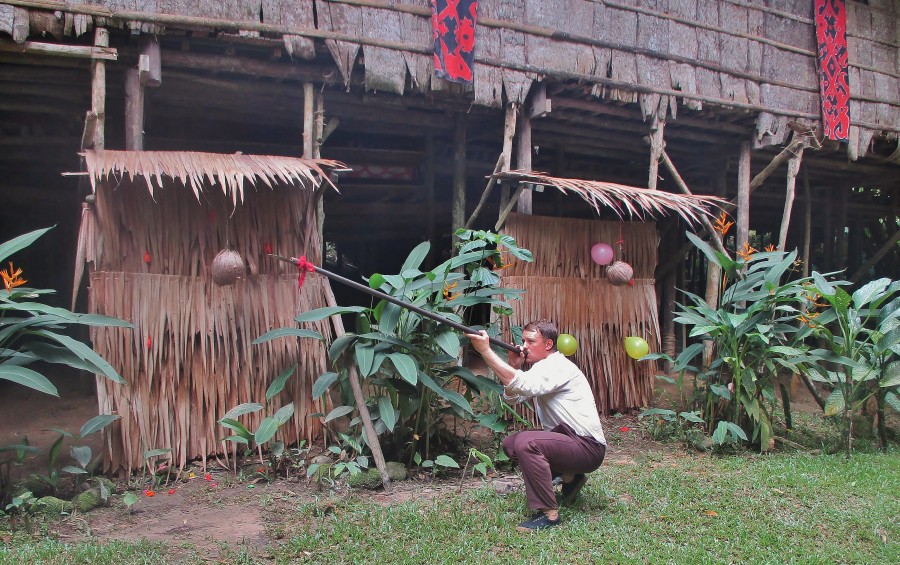
In the Mari Mari cultural village in Borneo, I discovered a new way for women. First, I dip my arrows in a sleeping liquid, then I choose a woman that I like, I pick her up from the ground and take her home. As soon as we get there, I chain her to the kitchen and then to my bed. As soon as I go back to England, I’m going to start a family that way.
The whole trip including transport and meal cost me 150RM. It was money well spent.
The mount Kinabalu climb (4095.2 m above sea level)
I think that the most important part of my trip around the state of Sabah, was climbing the highest peak of the island of Borneo – Mount Kinabalu (4095.2 m above the sea level).
On the first day I went by bus from Kota Kinabalu towards Ranau, what cost me 25RM. After less than an hour of driving I got out in front of the Jungle Jack‘s house, with whom I had already arranged my stay from the hostel in KK. He knew I would come. Jungle Jack lives opposite the park and regularly organizes trips. For 4 days and 3 nights in his mountain house with a gym and nice views, and for admission to the park with a climb permit, in 2018 I paid 1180 Malaysian Ringgit.
At Jungle Jack, I also met a few people who wanted to have political talks with me about Europe. It did not surprise me at all that the Germans were stupid and stubborn like a bunch of donkeys. From their statements, I understood that even if I sent them another 5 million Muslims, they would not have a problem with it because “they are not racists”. Unfortunately for the German idiots I can’t see big chances of survival, unless they happen to be smarter. There was also someone from the Netherlands, but his mind was so dark, that I didn’t even bother to talk to him. Oddly enough, the black man from the USA turned out to be the most sensible person, and he was so interested in me so much that he accompanied me to the top. He understood the ethnic change in the traditionally white countries, but then we only talked about the nature, although we spent some time together and ate meals together too. I therefore had a black travel companion and I understood that I was not a racist, because I was able to show respect to sensible black men.
I was genuinely disgusted with the white cattle, brainwashed by the Left beyond repair, though especially with a German woman – a fan of ethnic replacement. This time I preferred a black man, who despite being black had whiter mind than the white sheep from different corners of liberal Europe.
Mount Kinabalu is not an easy summit to climb, even though it is not as high as the others I was on. Although I’ve already been higher, I must admit that climbing Mount Kinabalu was very demanding, because in order to reach the top I had to overcome 8km uphill through the jungle on the first day. I often sat down because it was steep, but the views were very nice and changed with climbing. Once I sat under a waterfall.
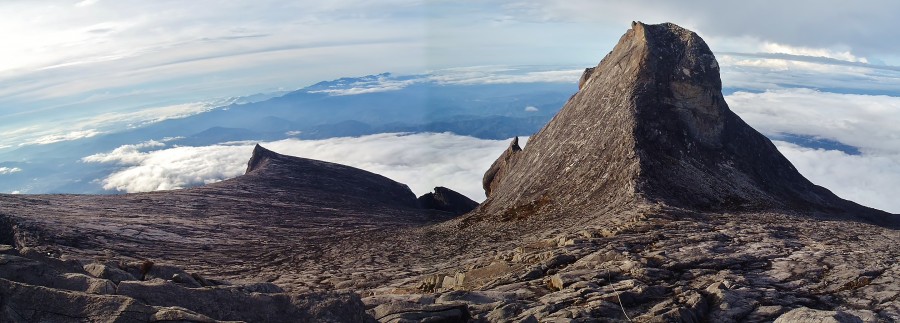
Views during my climb on Mount Kinabalu.
When I got to the Laban Rata base camp I had little time to rest, because I had to get up at 2 am and climb at night. I could barely get up, but I climbed up after all, avoiding sharp rocks and breathing cold air. When the line of trees and bushes was finished, the last part I climbed on bare rocks, holding onto the ropes. The views were beautiful, as was the satisfaction of getting to the summit. The last day was very tiring for me, because I had to walk 13km, first to the top and then down to the park’s gate. When I got to the Jungle Jack’s house, first I ate dinner, and then I slept until my headache finally finished. I was exhausted by this climb, like with no other before.
My experience after conquering Mount Kinabalu was very good, even though I could have climbed faster. I admit that my pace was too slow
My last days in Kota Kinabalu
My two last days in Kota Kinabalu were a time of relaxation. I was in a sea port bar to have on a really nice fish, and the next evening I ate a huge mussel in a tomato sauce, which proved to be harder to bite than a saddle on a horse. I was also shopping for coffee and tea from the Borneo rainforest (according to the inscription on the packaging), and reportedly picked by long-nosed monkeys. Then I had a massage for 50RM, and I went to the fruit bazaar, where I tried durian, mangosteen, rambutan, lansunis and marang. The exotic fruit of Asia are just another wonderful and tasty chapter of travelling around Asia.
I lived in Lucy’s Homestay, that’s why when I had the strength, first I went to see the Atkinson Clocktower, and then through the small jungle I climbed the Singal Hill Observatory. The food over there was bad, but there was a nice view of Kota Kinabalu from the top.
The Tip of Borneo
About 40 km from Kudat there is the phenomenon of nature and a very specific place. It is the Tip of Borneo, where even Ferdinand Magellan himself stopped by during his voyage around the world, and which for me turned out to be a very pleasant destination. The Tip of Borneo is a secluded place, near a picturesque beach with palm trees, lying on the northernmost part of the island of Borneo. I really liked it because I lived in a wooden house on the beach, and I fell asleep and woke up by the sound of the sea. I swam, threw myself into high waves and walked among the palms. Sometimes I had breaks for some food and to buy coconuts, which in my opinion are the best drinks in the tropical climate. I also often stopped by bamboo stalls under palm leaves to see the shells.
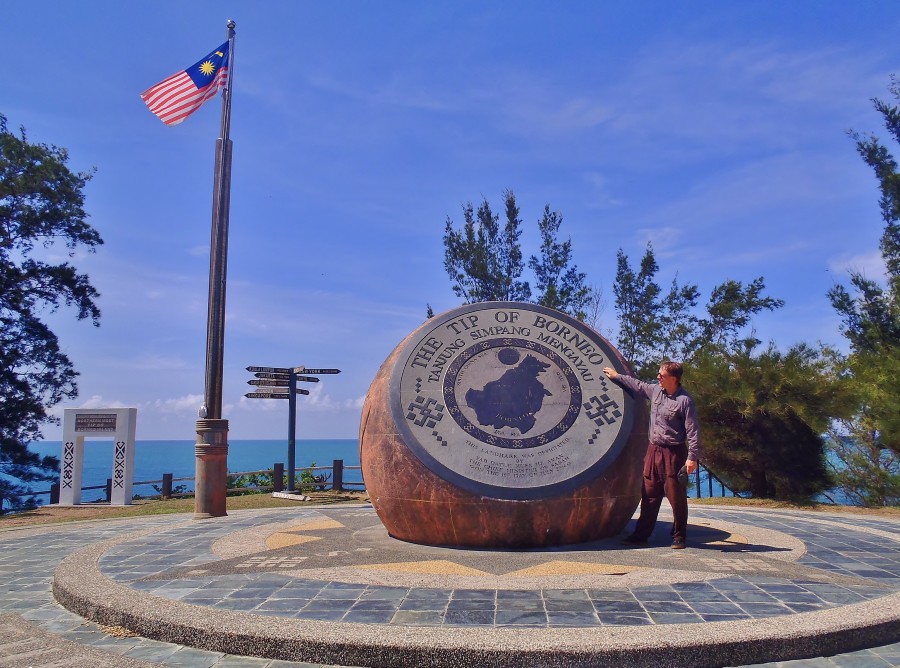
The Tip of Borneo, Sabah, Malaysia.
The Tip of Borneo is a spectacular rock formation, where the Sulu Sea meets the South China Sea, but for the tourist it is a very quiet and peaceful place. I went here many times to see the monument in the shape of a globe, showing the island of Borneo and the northernmost tip. I saw waves crushing against the rocks, on which I walked carefully many times. To me, the Tip of Borneo was exceptionally beautiful, and the waves waking me up every morning, which I later threw myself at, kept me for much longer than I planned.
Many tourists from Malaysia go to the Tip of Borneo only to see the monument, take a short walk on the rocks and leave quickly. For me however, the Tip of Borneo is just an attractive addition to the magnificent beach, the rock formations and exotic settings. It was very nice. The waves massaged me for several days.
Adventure in transport – from the Tip of Borneo to Sandakan
During my travel career it happened to many quite a few times, that I had spent whole days in transport. Although it may seem boring and monotonous, I think that “adventures in transport” allow for a better understanding of the country and its people, because they give new experiences.
From the Tip of Borneo someone picked me up off the road and let me off on the road to Kota Marudu and Kota Belud. There, at the crossroads, I had a dinner in a Chinese bar and I was so lucky that a group of young men took me from the parking lot to Desa Dairy Farm. The place is a dairy farm located in beautiful mountain scenery, where cows chew grass and breathe clean air. There are also souvenir shops, ice cream and other sweets made over there, and through the large glass one can see the cow milking. I never thought that I would go to a dairy farm, but it turned out to be a nice place on my way to Sandakan. Then, when driving through the mountainous Kundasang, my Malaysian traveling companions dropped me off in Ranau.
Then I had two short hitches, but finally someone took me straight to Sandakan, through Telupid. On the way we ate dinner at a Chinese restaurant, including a wild boar, and we arrived to Sandakan at 9 PM. During this trip I was usually fortunate enough to be driven by four-wheeled jeeps. It was a great ride through the mountainous, beautiful, clean, and adventurous Sabah.
Generally about Sandakan
Sandakan is an attractive city of Sabah, which has several historical buildings, parks and gardens, that would definitely keep travellers for a few days. Sandakan is a well-stocked small town, with great fruit bazaars, fish markets and fish restaurants by the sea; and a pleasant Malaysian atmosphere. In Sandakan I liked street food and sweets very much, although as usual I liked contact with happy people. Because I don’t drink alcohol nor smoke cigarettes, I used to go out for tea and walk by the sea in the evening.
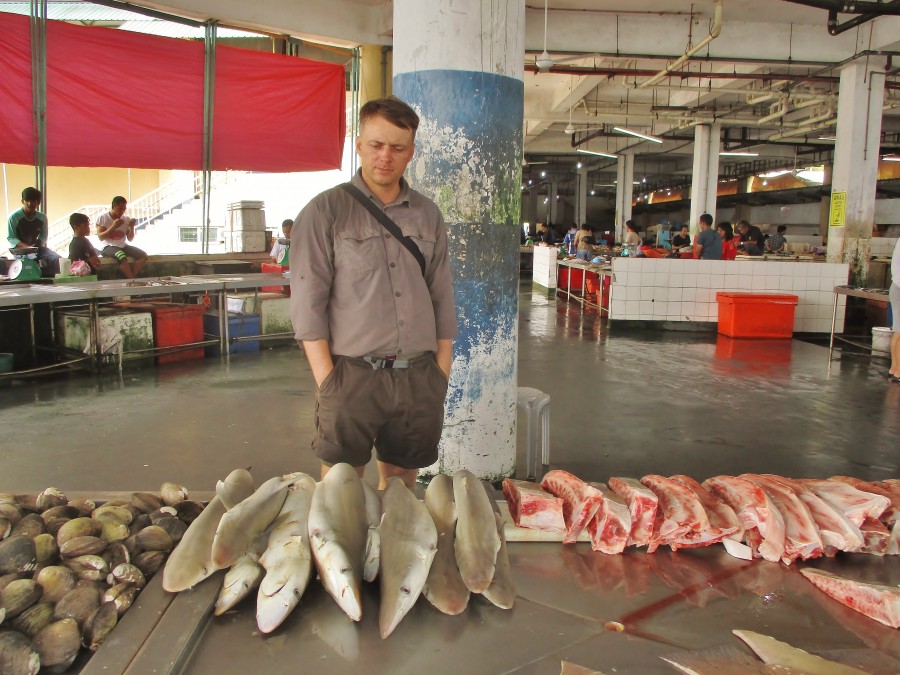
At the fish bazaar in Sandakan. Sabah, Borneo, Malaysia.
The people in Borneo were always curious about where I was from, and I greeted them and proudly answered that from Poland. I spent many evenings in the company of local people, and returned to the hotel with a bag of exotic fruit, such as: lansunis, mangostine and jackfruit. Unfortunately due to the strong smell, or rather the stench of that fruit, many hotels in Borneo do not allow durians. Sandakan is also a great street market in itself, where sometimes it seemed to me as if the trade never ended. When walking around the city one can find great deals.
I stayed at the Sea View Lodge from 30RM per night, and then I stayed in a dormitory for 20RM. I lived by the sea, and from my window I saw a fruit market and a souvenir shop of Borneo. There was also a very short walk to the very interesting fish bazaar, where I saw sting rays and sharks … ………. and sometimes even sea monsters, which are now supposedly extinct. I liked Sandakan so much that I even enjoyed my time in a laundry room, and I didn’t mind dirt in some streets.
Places of interest in Sandakan
Although the exotic and interesting Sandakan itself is already a tourist attraction in itself, there are a few places within the city, that I have seen and which are worth highlighting. All these places are located within a radius of about 5 km from the centre, because the various districts of Sandakan are relatively far apart.
Agnes Keith House – is a wooden house in a large garden that has been converted into a museum. Agnes Keith was a writer who came to Sandakan in the 1930s and wrote a well known book in Malaysia, titled, the “Land below the wind”. This museum presents the history of the Keith family, and shows the brutal Japanese occupation of the island of Borneo, which in Sandakan is well remembered. Agnes Keith was also imprisoned by the Japanese. The museum is interesting because of the history of Borneo in the times of World War II, and because it has many items from that time. In addition, there is an English tea house in the tropical garden, despite the fact that American Agnes Keith, after coming to Sandakan said that the city was too British.
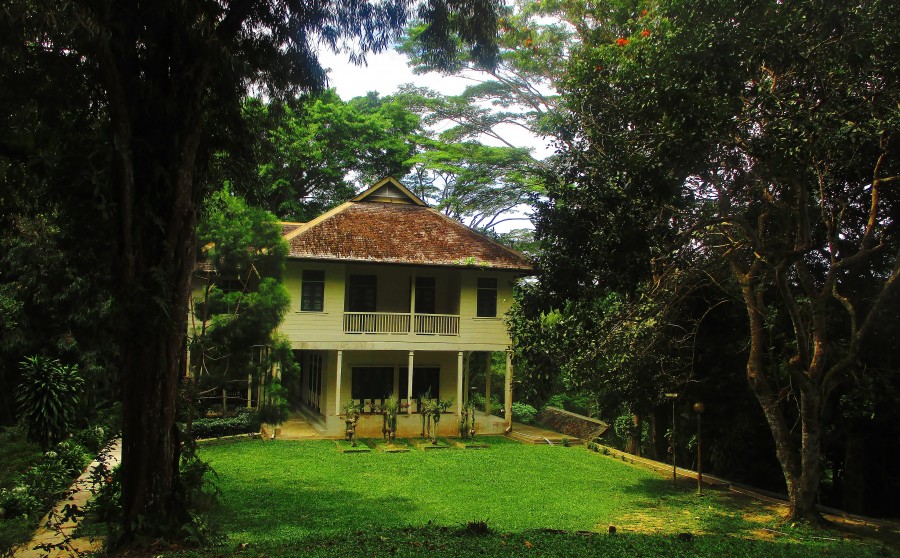
The house of American writer Agnes Keith, author of the book: “Land beyond the wind”, who lived in Kota Kinabalu during the Japanese occupation of Borneo.
The Agnes Keith Museum is located behind the Sandakan Hotel, near the port.
Near the Agnes Keith Museum, close to the Chinese cemetery, there is also the Japanese cemetery, founded by a Japanese woman, who by the way ran a very popular brothel in Sandakan. Interestingly, we could expect to see graves of war heroes there, but during World War II there were only graves of 100 prostitutes. Today, there is also a monument commemorating the Japanese soldiers.
Sandakan Memorial Park – is the former military base of Japan, where the imperial army began the memorable death march to Ranau. Here, where today there is a tropical park with beautiful Borneo trees and huge leaves, where nowadays there is a pond and one can see exotic lizards and birds, during the Japanese occupation it was also a prison for 1800 Australians and 600 Britons. By 1945 only 6 prisoners survived, and only those who managed to escape. In the park there are numerous pictures and information boards reminding about the tragic history.
In Poland, we learn a lot about the Second World War by rightfully demonizing Hitler’s crimes, although unfortunately we rarely talk about Stalin’s crimes and the crimes committed by Jews. I think it is also worth knowing what was happening at the time on the other side of the world, especially that emperor Hirohito was Hitler’s ally, and carried out such elaborate tortures on his prisoners, that the Nazis did not even dream of. I do not want to choose the worst of the worst here, but I think that in general Asians are more violent than Europeans, because Europeans are only brutal in order to achieve their goals, while Asians have elevated brutality to the level of art. Europeans are trying to hide their crimes, while Asians have written guides on that subject.
Fortunately, close to the “Park of Japanese Crimes” there is a pleasant place – the Crocodile Park. In that small area I saw green monsters, which were most active during feeding. At the roundabout near the Crocodile Park stands a huge crocodile, which points the farm with his finger, and that’s why the place is easy to find.
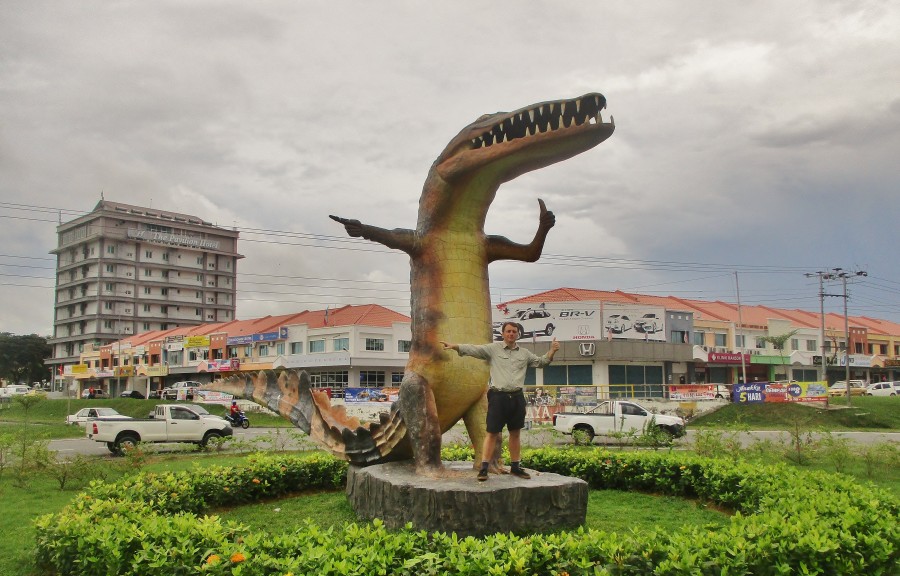
Crocodile shows with his finger where his farm is.
In Sandakan I went to see a large Chinese temple on the hill, called Puu Jih Shih. It is an attractive Buddhist temple with many Chinese ornaments, Buddha statues, with profiled roofs, and with dragons winding around red pillars. The temple is dominated with rich colours, ornaments and many sophisticated sculptures, while the views of the Sandakan from the top are spectacular. A characteristic features of this temple are also numerous swastikas, as symbols of peace. Lower in the garden there is also a green shrub in the shape of a swastika.
If you feel like it, you can also see the St Michael’s Anglican Church, which is the oldest church in Sandakan. The common thing about that church, and all the churches in England, is that they are always empty. The church itself however, and the great altar depicting saints, and vegetation all around were attractive.
Sepilok
Sepilok is the most popular place in the world to see Orangutans. In 2012, when I was traveling in Borneo the last time, I was in Semengogh in the state of Sarawak, where there is also an Orangutan Rehabilitation Centre. Even so, I decided that even after seeing Lok Kawi a few weeks earlier, it was still worth seeing once again those very special to me … Orangutans – the “forest people of Borneo”. In addition, there is also the Bornean Black Bears Reserve and the Rainforest Discovery Center. The lucky ones can also see pygmy elephants, Sumatran rhinoceros and gibbons. All these places are located in the forest area of Kabili Sepilok, which guarantees travellers and volunteers an opportunity to getting to know the beautiful nature of Borneo.
Near these centres there are hotels, what means that there is no need to drive 23km from Sandakan. If someone plans to have a longer contact with nature, he can have his base in Sepilok.
The Orangutan Rehabilitation Centre
The Orangutan Rehabilitation Center in Sepilok was opened in 1964 as the first official project, set to rehabilitate rescued and orphaned Orangutans from logging sites, plantations, illegal hunting or those which were kept as pets. Therefore, 43 km² of protected area on the edge of the Kabili Sepilok forest reserve was transformed into a rehabilitation site for Orangutans, and a centre built specifically for those apes. At present, there are about 25 young orphan Orangutans in nurseries, in addition to those in the reserve.
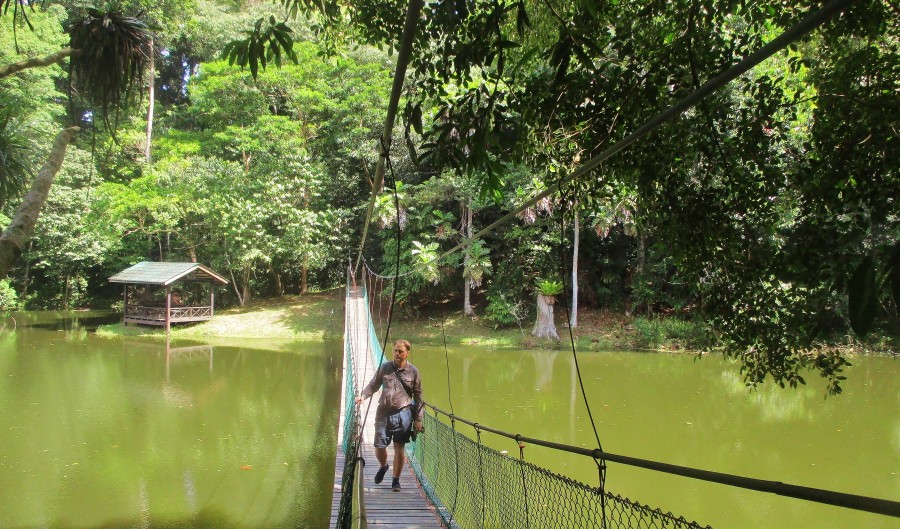
I walk on the rope bridge in Sepilok, in the Rainforest Discovery Center.
In the reserve there is a wooden footbridge running through the jungle, from where I saw Orangutansseveral times, wandering the jungle alone or in pairs. I also saw a female with a young one clinging to her fur, but in order to see them, we have to be lucky, because Orangutans do not approach us to offer a beer. At the sight of people, they run away, or they sit quietly in the trees and watch us. When walking through the jungle, I also saw Orangutans nests, because those “forest people” always sleep in a different place. For tourists, the best place is the viewing platform, where few times a day volunteers give them food. Tourists with good zoom are able to take pictures of them or at least see Orangutans in close proximity during lunch.
The Orangutan food is prepared in such a way that it is boring and monotonous, to force Orangutans to learn how to get food that they like on their own. Contact with people is very limited, because the purpose of rehabilitation is to adapt orangutans to life on their own.
Unfortunately, in Sepilok there is a „white man‘s price”. White people pay 30RM, while Malaysians pay only 5RM. Well, at least I gave more to the Orangutans.
Today, there are many organizations in developed countries that help protect Orangutans. These organizations collect money for their maintenance, research and security. Such type of Orangutan Loving Organization, of course also exists in England, but none of these organizations want to say why Orangutans are at risk. We know about the loss of their natural environment because to the huge palm oil plantations, which make Malaysia nearly 45 billion Malaysian Ringgit a year. But what is very important, the English who love Orangutans so much, do not want to admit that oil palms were introduced to Malaysia not by anyone else, by the British in the early 1870s, as an ornamental plant. Then, in 1917 the first commercial planting took place at the Tennamaran estate in Selangor, laying the foundations for huge palm oil plantations, and the palm oil industry in Malaysia.
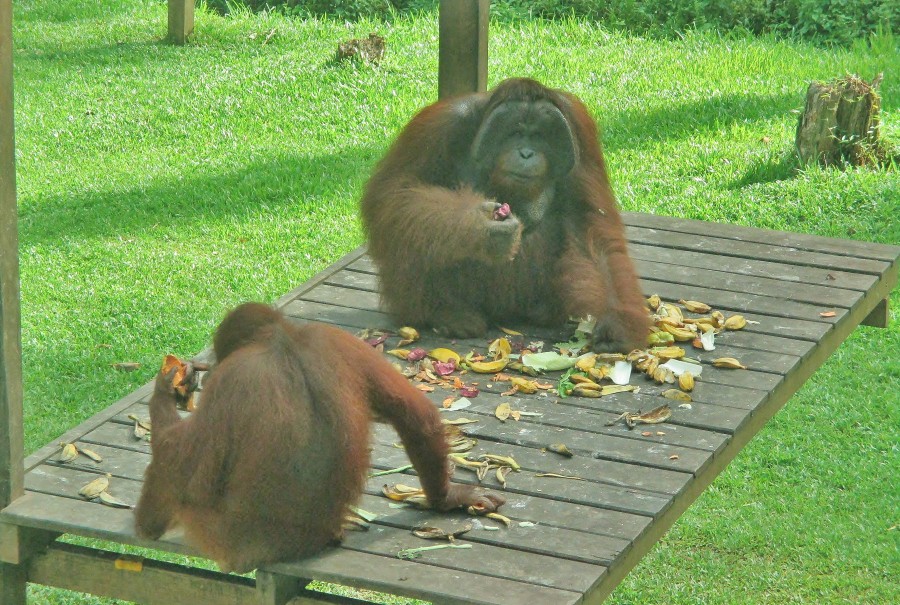
Orangutans in Sepilok.
I talked about this with a Malaysian man who gave me a free lift in his car. He said that no one knew oil palms in Malaysia until the British introduced them, so that under the pretext of a decorative plant, they could derive profit from the Malaysian land, and what in effect led to the almost complete destruction of Orangutans. Nowadays, English people pose to pictures with artificial smiles, when they hand over pay cheques for orangutans, but this situation is their fault. “Therefore first, the English hooligans broke orangutans’ teeth, and now they want to wash their blame because they cover 1% of their dentist expenses.” What a hypocrisy!
In Africa and India it was the same. English “gentlemen” used to shoot elephants, rhinoceros and tigers, just to take pictures with them, and now they have “merciful organizations.”
The Bornean sun bear conservation center
Beside the Orangutans there is a small but a very interesting and well-maintained centre, dedicated to the protection of the Bornean sun bears. This resort was opened in 2004, and its main job is to protect the world’s smallest bears. The black bears of Borneo re called „sun bears”, because of the yellow crescent under their neck. They lead an arboreal lifestyle, also when they sleep. Their characteristic feature is also a very long tongue, thanks to which they can easily lick honey from bee hives.
The bear centre is very well prepared for visitors. I stood on a wooden platform and watched bears sitting on trees and those sitting on the ground. There was also a telescope, through which I managed to take a few photos up close. Sun bears are the least known species of bears in the world, and the second rarest, after pandas. The biggest threats are the loss of the natural environment, poaching, and keeping them pets in private farms.
The Rainforest Discovery Centre
It is a separate part of the jungle, where tourists can admire the beautiful tropical flora and fauna. In the jungle there is a botanical garden, a lake surrounded with exotic plants and a 1km long walking trail. There are also 8 towers connected by walkways, thanks to which one can see the jungle from above. The Rainforest Discovery Center is a place where I spent a very pleasant time in the bosom of tropical nature. One can also go there at night to see flying squirrels, civets and other animals. Everyone who loves nature should definitely go here.
Kinabatangan river
After returning from Sandakan I went to the Kinabatangan river, which is one more place in the state of Sabah, where one can admire the nature of Borneo. Sungkai Kinabatangan is 560km long, it is in a colour of tea with milk, and ends up in the Sea of Sulu. I lived in a room by the river, and for two cruises and two nights with breakfast I paid 200RM. Transport from Sandakan cost me 50RM.
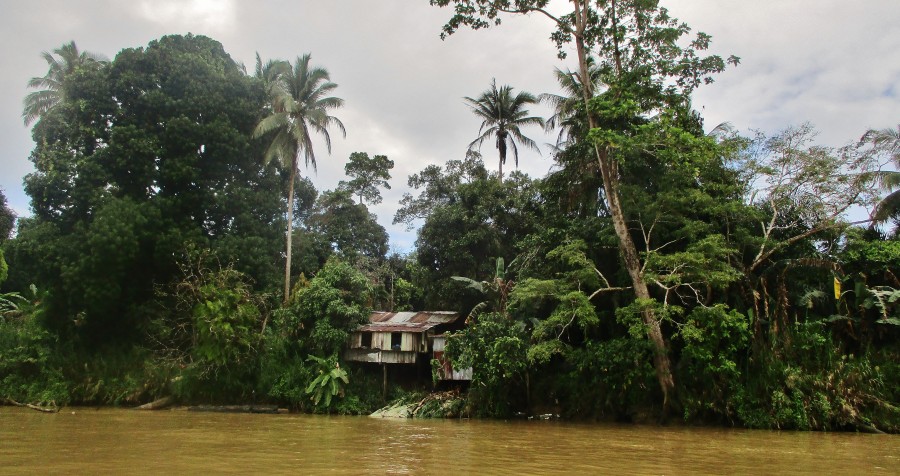
Kinabatangan River, Sabah, Malaysian Borneo.
River cruises in search of wild animals are the most important part of the program. I only saw wild pigs and colonies of monkeys, but people travelling before me also saw pygmy elephants crossing the river, and even wild orangutans. The cruise itself, even without animals, is still very pleasant and relaxing because I was sailing through a wide river and its narrow canals. I saw monkeys a few times, and ones, one of them came down from the tree, pulled out a paw towards me, and I was so nice that I gave it a cracker.
In the evenings I used to go out to wooden restaurants by the brown river, I talked to people, and unfortunately I saw a lot of oil palm trees, which to Orangutans are the symbols of greed and death. I think that every traveller eploring Borneo should definitely see that place. Those who are interested can also cross the jungle with a guide.
Gomantong caves
On the way back to Sandakan I stopped at a turn to the Gomantong caves, which although is present on a tourist trail, it is often overlooked. The cave itself is huge, and also secured, because there is wooden footbridge inside. About 275.000 bats live in the cave, what means that it is important to walk carefully, to avoid breaking a neck on their shit. I liked the entrance to the huge Simud Hitam cave, and the view of the exit from the end of the cave. There’s also a smaller cave, Simud Putih, if someone feels he hasn’t had enough.
I paid 30RM for entry, because I’m white. Malaysians pay only 5RM.
Gomantong Caves are one of the main places in Borneo to collect swiftlet nests, which are ordered by the rich Chinese, and then are processed into soups. One kilo of nests costs as much as $10,000, that’s why for poor Malaysians it’s a good deal, even though they have to put bamboo scaffolds on the edges of dark caves. Bird’s nests are made of bird saliva in a solid form. The Chinese say that the bird’s nests have medicinal values, like apparently the shark soup and the rhinoceros horn, but I doubt it. In my opinion, this is the whim of rich Asians who affect animals in a bad way.
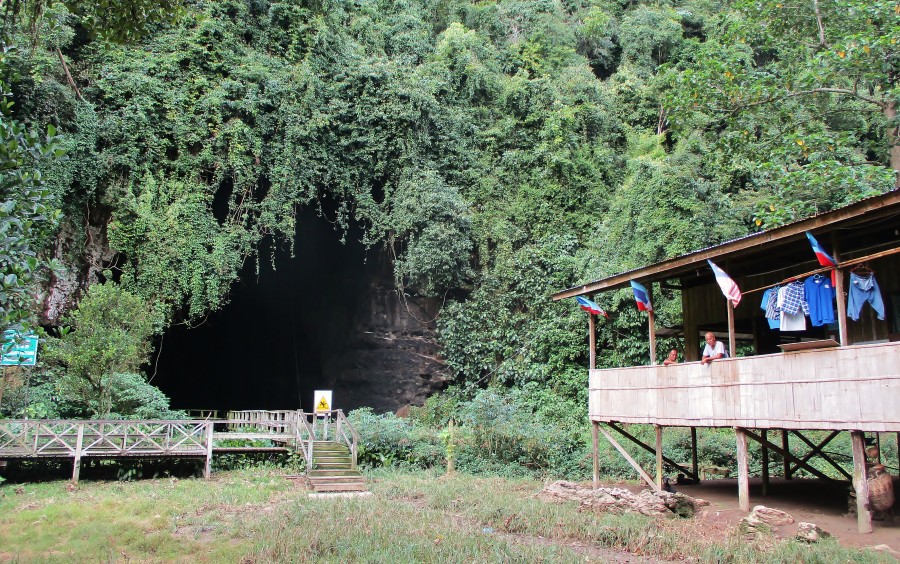
Gomantong cave.
Getting to Gomantong caves must be done by own transport. I went back to Sandakan by a few cars stopped on the road, with a stop over in Bukit Garam, where I went to an Indian restaurant.
Labuk Bay – the proboscis monkey sanctuary
Proboscis monkeys, next to orangutans, are among the most important symbols of the island of Borneo. Those funny monkeys live in herds run by a dominant male. Labuk Bay is a separated mangrove forest, designed to protect those wonderful animals. Proboscis must be protected because palm oil plantations are a very profitable business in Malaysia. For thiat reason, the natural environment of endemic animal species is being consistently destroyed.
In Labuk Bay there are two main entrances lined with wooden footbridges, leading through the mangrove forest. Each footbridge leads to an observation deck from which proboscis monkeys can be seen from a close distance. I found it especially interesting and uplifting when I saw a whole bunch of them, eating cucumbers, beans and sometimes even pancakes. Proboscis are cute, furry monkeys, which everyone would like to hug, but unfortunately touching them is not allowed. It happened to me a few times, when monkeys which were familiar with people walked next to me, and one even sat on a chair at the table – when I had a banana in my hand.
Actually, I could sit there whole day and just watch those beautiful, funny creatures, who live in specific social structures. The dominant male is not a gentlemen, because he always eats first, even befire females with babies. On the other hand, he is very vigilant and protects his herd.
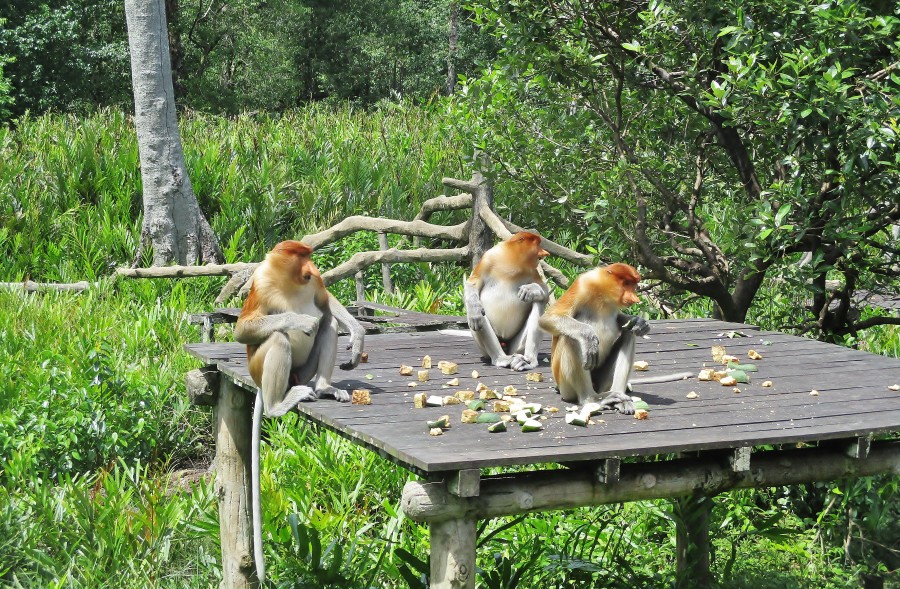
Proboscis monkeys in the Labuk Bay sanctuary.
In addition, I walked in the Labuk Bay forest and i saw several monitor lizards running on the road. It is a real shame that oil palm trees grew everywhere, because without them maybe I would see orangutans.
In order to get to Labuk Bay from Sandakan, it is best to get a minibus from the Sandakan hotel. The ride costs 40RM for a round trip. Own transport is problematic.
Semporna
Semporna is a small, uninteresting town with a few shops and hotels. It’s one of those places which doesn’t make an impression, and which you want to leave as soon as you get there. In general Semporna town is made of a few concrete blocks, stuffed with food and various goods. Fortunately, I had a very pleasant hostel for 30RM with breakfast, and there was a grill nearby in the street. After some time however, I got used to it, and it was nice, especially when people come out with their street stalls.
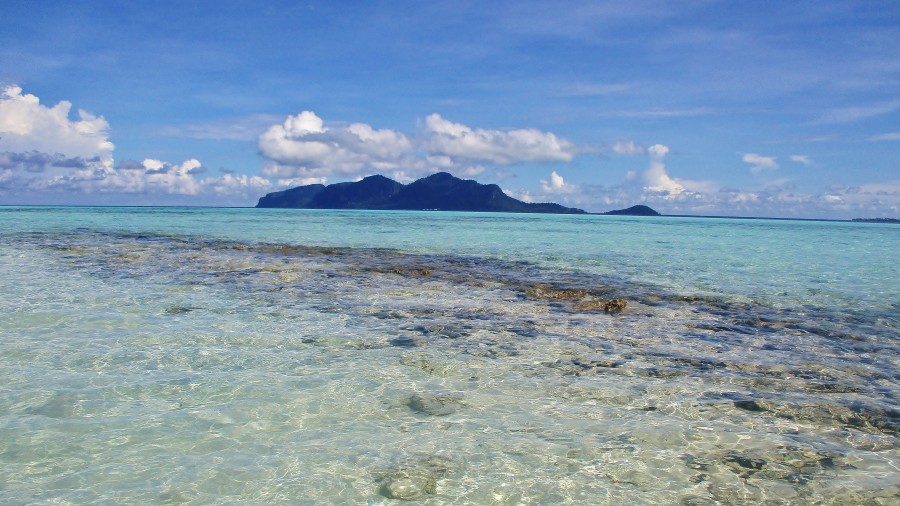
Landscape of the Semporna archipelago.
Every evening I had a great fish straight from the sea, and I bought tropical fruit. I spent a really nice time there.
Semporna archipelago
The Semporna Archipelago is a popular tourist destination at the outskirts of the Malaysian Borneo, because of the National Marine Park, which is one of the centers of tropical diving. The town itself is not interesting, but nobody goes there to admire the vendors of mango or grilled chicken. The natural beauty of Semporna is amazing, and the legendary Sipadan enjoys the greatest popularity among scuba divers. Unfortunately, prices for diving near Sipadan I describe as a “heavy landing”.
The Semporna Archipelago is an exceptionally picturesque group of islands, where despite the divers invasion, live local people. For that reason, Semporna also offers cultural experiences, because whenwalking through the islands, and crossing wooden footbridges high above the water, and then walking in the beaches, I reached wooden houses where local Malaysians sold shells, beads, ornaments made of gifts of the sea, and of course coconuts under palm trees. It is also necessary to understand that what we see above water is one world, while there is another world under water. It is a world of diverse corals, huge rays, sea turtles and sharks.
In order get to know the Semporna archipelago better, I think it is necessary to buy several day trips, or those which last two or three days. Then we would have the chance to enjoy the beauty of the tropical, aquatic nature, and get to know the culture of the local islanders. I remember that during my walk on one of the islands, one Malaysian shouted to me, asking what I was throwing into the sea, to which I replied that I was returning the shells where they came from. He just smiled. Local people really care about the cleanliness of their islands, and tourists should do as well.
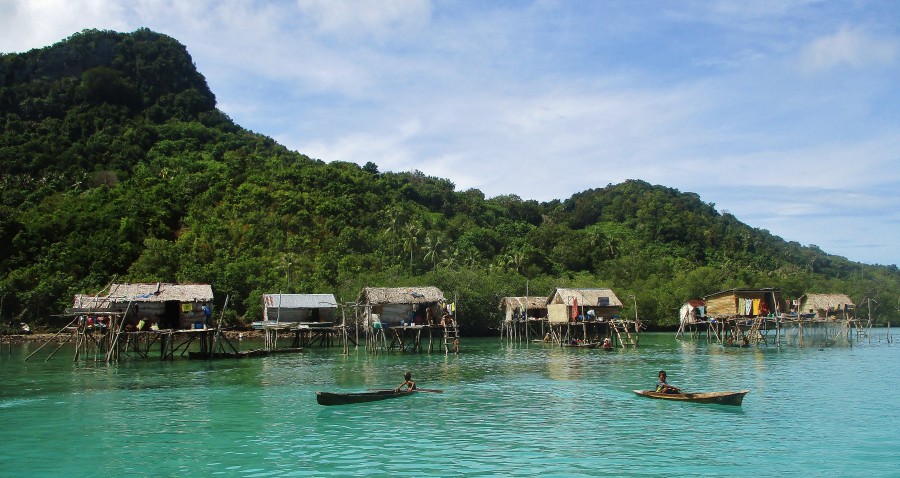
Water village in the Semporna archipelago.
The word “Semporna” is little known even among divers. The “key” word here is “Sipadan”, which outclasses coral reefs in other parts of the archipelago. This doesn’t mean, that other reefs are bad, because to Whites every corner of Malaysia look tropical and attractive.
Tours around the Semporna archipelago
Mabul
On the first trip I sailed to the Mabul island, where I spent 2 days and 1 night. I lived in a dorm room abovethe sea, as my house was built on wooden posts, and the foundations were built in the depth. That small wooden house was connected to the mainland with wooden bridges. I also had meals and a diving base on site. In addition to all the great beaches, coconut palms and view taken from picture perfect postcards, I also liked contact with people from the Mabul village. I played football with Malaysian children, I bought some souvenirs, and I talked to them a lot.
I had two scuba dives ear the Mabul island and I snorkeled a few times. Once I dived in a magnificent coral reef, full of small creatures. Another time I went down to a depth of about 20m to circle around wrecks, where I also saw interesting sea life. I saw a couple of sea turtles, many small fish and one big one – a giant grouper. Compared with other small fish, this giant looked like an underwater tank, though it was very shy.
After two days on the beaches and under the water I went back to the Semporna town by boat. My stay cost me 190RM, including transport by boat, 1 night in the room, and two meals. Two hours of diving cost me 240RM, but in Sipadan, which is an underwater paradise, diving would be much more expensive and would still have to be booked in advance. My time at Mabul was very pleasant and calm.
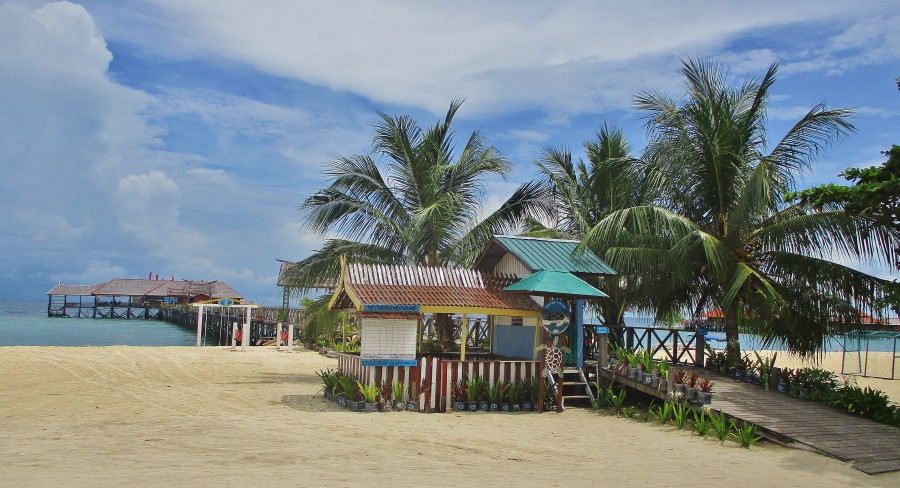
Mabul island in the Semporna archipelago.
I want to add that after dark I walked on the bridge with a flashlight to watch sea turtles eating plankton from the depth of the sea.
Bohey Dulang + Mantabuan + Sibuan + snorkelling
The next day I took a trip to the three islands, which I can shortly describe as moving around paradise beaches. Unfortunately, I had only a few hours on each of the islands, but still, I could not complain about the turquoise landscapes with palm trees and white sand.
Bohey Dulang is an island, but I will rather remember that little piece of land as a strip of sand appearing from blue water, with a few palm trees. Unfortunately, some tourists go there by big boats, and for some reason they need loud music. I prefer peace.
Then we moored somewhere in the sea where I was snorkeling. I was lucky again because I was able to see a sea turtle. There was also a cultural attraction of the day nearby – a small village on wooden posts. It was a very special sight, because I saw wooden houses covered with palm leaves, and children who were floating near me on wooden canoes. The expressions on their faces, the way they rowed and tried to sell grilled fish, were in themselves a nice cultural shock, which I always look for in my travels. Definitely, it was the clash of two completely different worlds, and I hoped that those people were happy, because I was when I saw how they lived.
Mantabuan island is yet another beautiful corner of the Semporna archipelago, with a picturesque beach and palm trees. Tourists usually have meals on this island. I took a walk, I saw red starfish and I was swimming of course.
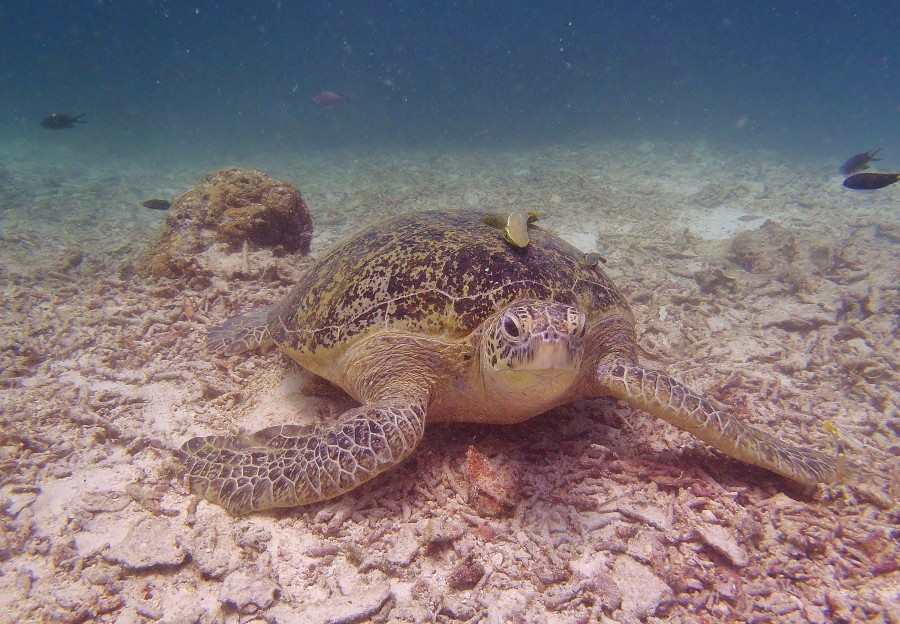
Sea turtle.
At the end I went to the Sibuan island, where I was walking and swimming, and what took me about 3 hours. The beach, turquoise sea, palm trees, starfish and warm tropical rain. That’s what my business was about in Sibuan.
Timba Timba + Mataking + Pom Pom
All these places were similar to the ones I saw on the previous day. It is true that there were some other landscapes, and as usual, the sea, sun, palm trees and sand did not disappoint me too. I also decided to take an hour just for snorkeling among the coral reefs. When I went lower, I was able to see a huge sea turtle. I realize that everything looks larger under water, but that one was bigger than me. Besides, I walked around the white sand bar, that was sticking out of the water, and I spent a very pleasant time on the boat.
That day I was on a boat with two young English women. In the beginning it was quite nice, but then the girls did what they could to treat me in a rough way. They were moody. However, we took pictures of each other, one of them threw me a mask and a camera when I was in the water, and the other one was so nice that the day before she had put after sun lotion on my back, because I had been burned in the Borneo sun. For the first time in my life I thought that I met English women who I could really like, and I felt that I wanted to be good to them. It seemed to me that everything would go well, but unfortunately that beautiful day ended badly, when one of them told me that she was a “black whore”, and I said what I thought about it. Then it got even worse, because she asked me “what was wrong with that,” but she also didn’t let me explain it to her. Her friend was not a “black whore”, and I saw that she felt inconveniently, because it looked that she did not agree with her. Even so, she criticized me, because she didn’t want to lose her friend.
After the last hour of our cruise, spent in absolute silence, the English women were waiting for me at the port, so perhaps I could talk to them again, but I just walked by in silence, because one of them I could not respect anymore, and talking to the other woman did not make sense. I’m sure they remember me because they read my articles. Maybe they learned something ??? Maybe someday they would get in touch with me? It is a shame, because under proper discipline they could become good women.
I was sorry that I had to end it this way, because I wanted everything to go well; but in spite of that I didn’t regret my decision. If white men accept the whoredom of white women as the common normality, then it would be the end of our race!
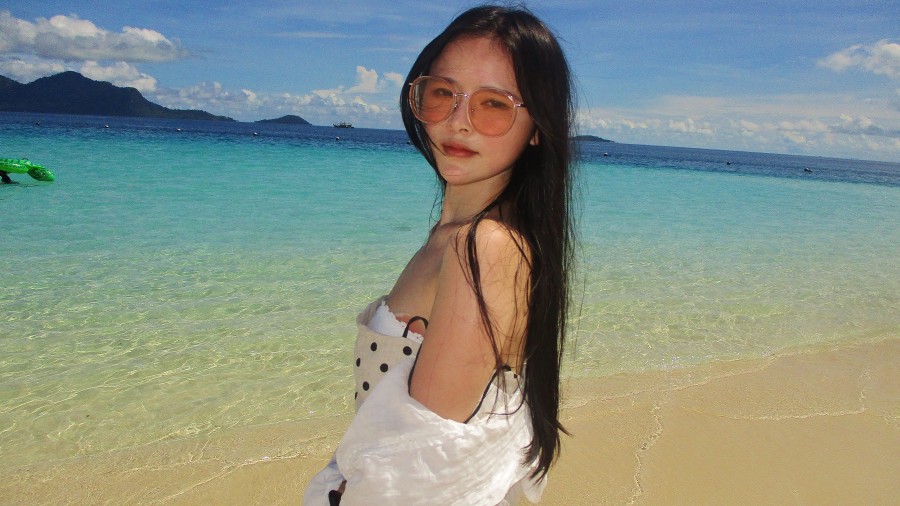
Oriental kitten on the beach catwalk.
Tawau
Tawau is a town, which travellers might not remember till the end of their lives. It is true that the streets are clean, and the locals smile and serve good snacks, but the town itself is small and not interesting. Tawau consists of a concrete blocks, composed of hotels and shops, where life begins after dark, and when locals attend fruit bazaars and make temporary restaurants under the open sky. Despite that, I enjoyed the experience of Tawau. Some say that it is not worth staying there for a night, but I don’t agree with that.
Tawau found itself on the Malaysian Borneo travel map, because the nearby airport. In addition, Tawau lies close to the Indonesian part of the island of Borneo – Kalimatan. I was in Tawau to get to the airport and fly to the Philippines, but other travellers go there to visit the consulate of Indonesia and buy an Indonesian visa.
I on the other hand decided to see more, and that’s why I went on trips from Tawau, which I’m going to talk about below.
Trips from Tawau
Contrary to the popular opinion, I did not want to remember Tawau as a base for the airport. I wanted to see something beautiful, which is why I decided it was worth visiting two interesting places.
The Sanakin hot springs is an attractive place among tropical nature. Some pools are warm and other ones are hot, so one can choose. I spent a few hours in the pool, inhaling the warm steam and clean air of Borneo. Warm springs, palm trees, exotic nature. That was all I needed to be happy.

In the Sanakin hot springs, near Tawau.
Tawau Hills Park is a protected area, with tropical peculiarities of Borneo’s nature. I spent over 3 hours in this park, walking along the trail through the tropical jungle, bathing in a warm spring, and then also under a waterfall. Noteworthy here is “the highest tree in the world”, and climbing the Bombalai Hill (530m), what takes about 30 minutes. I was there, of course.
My time in Tawau jungle was not easy, because on that day it was hot and mosquitoes were biting me all the time. Then there was a warm tropical rain that wet me completely, and forced me to walk through mud. In order to relax from mosquitoes, dirt and sweat, I took a shower under a waterfall, and during that time I hung wet things on a tree. A spider came into my shorts and an ant into my shirt. Because of that I had to wet my clothes again, put them back on, and wait for the sun to dry them. That’s what happened, but it was not an easy day.
From Tawau to Tawau jungle I paid 36RM for transport by grab, and 15RM for entry. However, my return to Tawau was heavy and risky, because I was in a hurry to the airport, and I was lucky enough to take a hitchhike, otherwise I would miss a flight. A group of Malaysian boys took me aboard, and we drove quickly through palm oil plantations on both sides of the road, I finally got to Tawau town, and I thanked them warmly.
It was indeed a very adventurous day, which was not over yet.
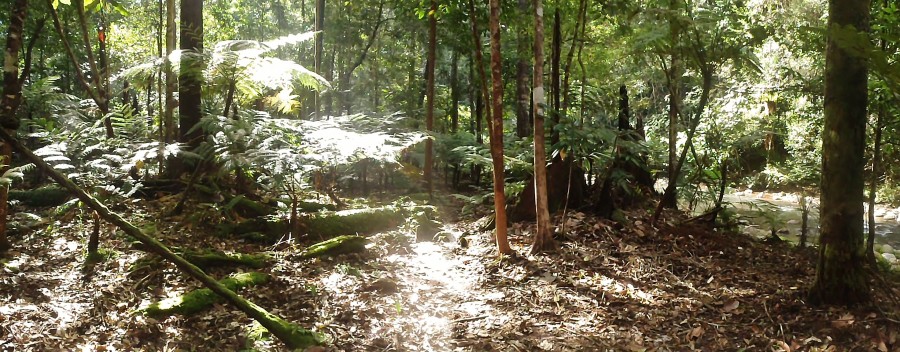
Landscape of Tawau Hills Park.
The summary of my journey around Sabah
Organizing a trip around Sabah was the only undertaking, that I missed in order to complete my Malaysian adventure. Sabah is a state of tropical vegetation, unique animals, jungles, waterfalls, paradise islands, caves, and interesting culture and traditions of the people living there. I think that everyone should visit Sabah to make his life better and to have more interesting memories. Orangutans, proboscis monkeys jumping on the trees, a milk tea-coloured river, and the specific climate of the island of Borneo. One adventure is a continuation of the next, and the taste of the adventure is enriched with tropical fruits and exotic fish on plates, caught from the Sulu Sea and the South China Sea.
Adventures in transport
I arrived at the airport in Kuala Lumpur at night, and was waiting for a flight to Singapore at 10:55. I thought I didn’t want to sit at the airport, so I took the first LRT train to the centre to see Petronas Towers again. The train cost me 50 RM, but I preferred to spend money rather than get bored. From there, I also went to the Merdeka Square and again to see the attractive Masjid Jamek mosque. Unfortunately, I had very little time, so I had to run, but I still missed my train to the airport. At the end I paid a little and went to Singapore at 16:40.
Last time I was in Kuala Lumpur in 2012, and I really wanted to see a few places in the center again. It was a pity that I had such little time.
I got to Singapore in the late afternoon, around 6 o’clock. The flight to Cebu City was next morning, that’s why I went to the centre by train. It was already dark and I knew that I couldn’t plan a big tour, but the same as just a few hours earlier in Malaysia, and in Singapore I didn’t want to sit at the airport. For that reason I went to Bayfront station by MRT, and from there I went for a walk to see Marina Bay Sands by night. It was very nice, even though I already knew Singapore very well. Among other things, I had a good dinner in a new, clean shopping centre, with a canal and with boats for rent, and the rest of the time I spent on walks around Marina Bay.

Masjid Jamek in Kuala Lumpur.
I was heading toward MRT, but I saw the Singapore casino, and I thought I would try my luck. I still stank with the Bornean Jungle, which is why I looked rather like I was going on an expedition into the wild, and not like a gentleman going to a casino. Anyway, I managed to win $500 in roulette, but then I lost half. I came to the conclusion that I didn’t trust roulette tables in thay casino, because when I put on the black, in the last moment the ball jumped on the red. I collected my $250 and left.
I went back to the airport by first MRT, and this time I was on time. I soon landed in Cebu City. After a beautiful trip to Borneo I returned to the Philippines.
Return to the Philippines
After landing in Cebu-Mactan, I took a bus from the airport to SM City for 40 pesos, and then a taxi for 150 pesos to Colon, in Downtown.
This time my stay in the Philippines was not supposed to be long, and that’s why, according to the plan of my trip I only missed the best places on the Cebu island. Cebu is a very special island in the Visayas archipelago, because it has beautiful beaches, exotic islands, good diving and whale sharks. Cebu is an exceptionally charming part of the Philippines.
I knew that my trip was almost finished there, that’s why I only wanted to see what I had planned, and then I just wanted to get to the airport. I spent my first two days in Cebu City. As before, I lived in a Teo-Fel hotel for 400 pesos a night, and on the first day I was just resting. I had to do the laundry, sleep after Borneo’s jungle, and after a few stop-overs in a few random places of Asia. When I felt better, I went to Downtown to see the Santo Nino Cathedral and the Magellan’s Cross again, and I spent the rest of the day at the Carbon Market, where I show an interesting video. I also went to Uptown, where I sat with Filipinos on the green roundabout – Feunte Osmena. Even though there was no water again, I had a nice time.

Ruch uliczny w Cebu City.
My time in Cebu City was very pleasant, and not only in the attractive places, but also when I watched jeepney, traffic and thousands of street vendors and telephone repairers.
During all this time I was traveling alone, and I thought it would be nice to meet someone normal, with whom I could spend some time. It is a pity that it turns out to be impossible. In the hostel I met a girl from Germany, who has not yet found her mind. Generally, Europeans travel to learn about foreign cultures and it is important for them to preserve alien civilizations, while condemning their own to extinction. The German woman was a great enthusiast of the Islamization of Germany, but on the other hand she did not want to see Muslims in the Philippines, because it was a Catholic country. The concept of race in her mind was absent. I have met a lot of such Germans, what proves that this nation has no future. In addition, according to her: “what is the point to have German children, if Muslims in Germany have 4-6 with a few women, and still everyone is equal because they have the same skeletons.”
Trips outside of Cebu City
Travellers who plan trips around the Cebu island and its adjacent islands, from the point of view of tourism should divide the island into two directions: the southern direction and the northern direction. This is the way to organize trips from Cebu, because only this way makes sense. For that reason, in Cebu City there are 2 bus stations, the southern and northern station. On each one of them one can buy good fruit, drinks and sweets, and stations in the Philippines are bustling and cheerful places, although the organization is not always the best.

Magellan’s Cross in Cebu City.
The southern direction is: Oslob and Moalboal, and several adjacent islands and waterfalls in the area. First, I advise to go to Oslob, and then on the way back towards Cebu City I advise to stay in Moalboal.
After returning to Cebu City and spending at least one night there, I advise you to go north.
The northern direction is: Bantayan Island and Malapascua Island, and several other beautiful places along the way. Travellers can rent a private boat for extra money, which can be sailed directly from Bantayan to Malapscua, although the main route runs through the large island of Cebu.
Oslob
Oslob is a small Filipino town, which has found itself on the tourist map of the world thanks to whale sharks. These biggest fish in the world fuel the economics of the town and the whole area, thanks to which people built houses, they opened stores, and they live better. I quickly found a room for 300 pesos a night, and spent the evenings on the grill with locals. In addition, there is a nice church in Oslob, a lot of shops, and in the evenings by the sea, there is a funfair with sellers of ice cream and fruit.
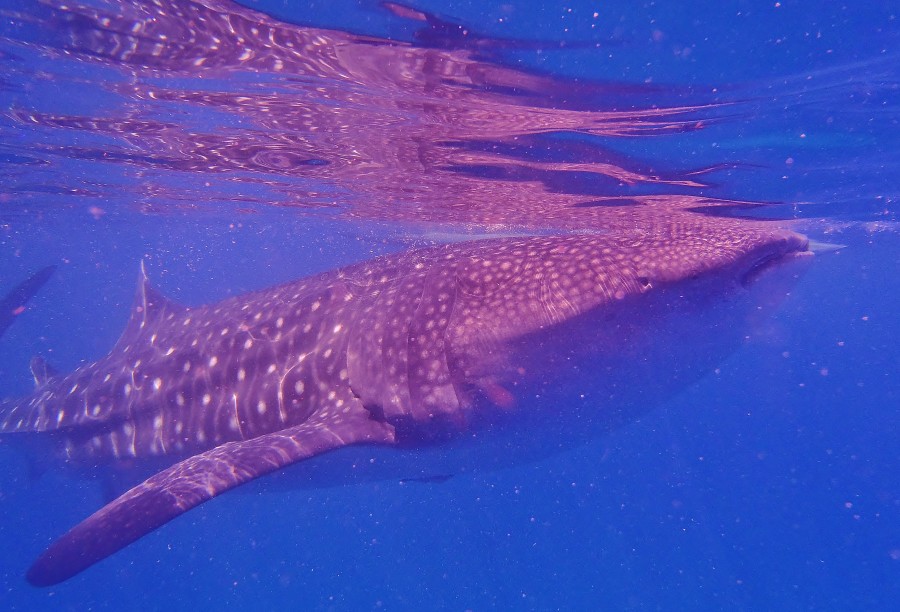
Rekin wielorybi.
Oslob is a very nice tourist town, but all the things that are there are just an addition to whales, which can be seen 7km out of town.
Whale sharks
7km outside Oslob there is a very touristy and a very commercial beach, where tourists from all over the world come to see the largest fish in the world in the natural environment – the whale sharks. These “delicate giants”, as they are often called, feed on plankton and small fish by filtering water, and are not dangerous to humans. They reach an average length of about 6-10m and a weight of up to about 10,000kg, although the largest individual measured 12.65m and weighed 21.5 tons.
Whale sharks are present in all warm oceans in the southern hemisphere, even though those fish occur seasonally in specific locations. In Oslob however, the locals made such a lucrative business out of whale sharks, that they are there all year round, because the locals feed them with bread and shrimps. The money that Filipinos currently earn on sharks was impossible for them to imagine. The locals themselves told me many times, that they loved their sharks very much, and I am not surprised at all. Also, a full scale souvenir business has started in full swing, and before we even pay to see sharks, we can buy magnets, postcards and shark T-shirts.
Since early morning there are always a lot of tourists on the beach, who have 3 payment options. Some people can watch sharks from the boat, which costs 500 pesos. Others can snorkle around them, and this is an option that I have chosen and which cost me 1000 pesos. The most expensive option is scuba diving, which costs about 2000 pesos. I was happy that I could be with sharks in the water, because I saw how huge they were and how they behaved. After catching food thrown by the fishermen, they quickly disappeared in the deep blue. Of course, it was a very valuable experience that I do recommend.

Rekin wielorybi za Oslob.
Tumalog Waterfall
Near the beach with whale sharks, there is also the Tumalog waterfall. It is a very nice blue pool in the jungle, with interesting rock formations and large bamboos. I paid 30 pesos for entry, and I recommend this pleasant contact with nature. When bathing in a blue pool, and then taking a shower under a warm waterfall, I met two sexy lesbians, and I must admit with great regret, that they were wasting their lives. I hugged one of them and then I came to an opinion, that they were good women with inappropriate interests. The lesbians were very sexy and men standing there liked them very much.
The blue lagoon, rocks and waterfall are large and encourage to stay longer. Tumalog Waterfall is one of those places that you do not want to leave, also because of the silence of the jungle, combined with the sounds of nature.
Sumilon Island
I think that in this case I will not use a lot of words. Simulon is a tropical island near Oslob, where I spent the whole day on a white beach and in the blue sea. A return boat costs 500 pesos. It is heaven on earth.
Transport from Oslob to Moalboal
I decided, that in order to not be boring, I would have another adventure in transport. First, I went to the village of Santander, which is just a transport hole. There I got on a bus, and I got off right in front of the Samboan village, to have an adventure in the Aguinid and Binalayan waterfalls. For several hours I walked around the jungle, climbing different levels of waterfalls. Fortunately there were ropes that I could hold on to, so it was safe. I had a guide who took pictures of me and showed me the trail. Some places were noisy and the water was rushing quickly, and the other waterfalls were peaceful and quiet, located in the isolated jungle.
I spent beautiful time there, and after leaving the jungle I bought rambutans from the Filipinos, and sat down with a coconut under a palm tree. It became clear to me many times, that a very simple life gave me the biggest happiness. Because the Aguinid waterfall is popular with tourists, there are also people living there in wooden houses under palm leaf roofs, who run their small shops.
Then, travelling at the back of moped I arrived to the hotel by the sea, where I took a room for 300 pesos overlooking the sea. I felt great there, and the next morning I was awaken by the sound of the sea. In the evening I went to the Ginatilan town to eat something at a private grill. I will always remember Ginatil as: grill, church and a basketball court.
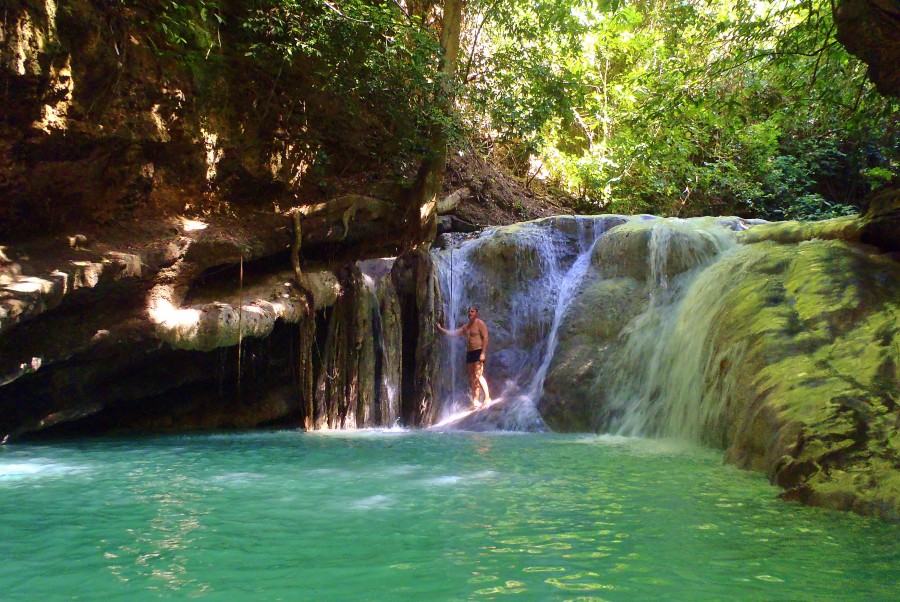
One of several elevations of Aguinid waterfalls. It is the less-known natural beauty of the Philippines, on the island of Cebu.
The next morning I went by bus to Moalboal, for 250 pesos. Along the way I had a stop-over in Badian, for a barbecue snack. It was nice, but the locals enjoyed making fun of me. Well, that’s fine.
Moalboal
Moalboal is yet another paradise place in the Philippines, near the sea and waterfalls, where one can forget about the stench of everyday life in a European country. Moalboal and its surroundings are one of the most pleasant places on the island of Cebu.
Moalboal is divided into two parts. The first part of the city is Moalboal for local Filipinos, which is further away from the beaches. In this part there is cheap grill at the bazaar, where tourists can buy tropical fruits at normal prices, rent a moped, and where there is also a very important bus stop. I loved the local Moalbooal, because through my time, that I spent on fruit bazaars and through contact with Filipino fishermen, I experienced the reality.
The part of Moalboal, which is located closer to the beaches is a tourist town focused primarily on diving, where prices are also adapted to the tourists’ portfolios. I lived in a dorm room for about 350 pesos a night, I was close to the seaside pubs and beaches, and it was great. It was so good that I planned to stay 3 days, but I stayed one week. In principle, the life of tourists in Moalboal is usually limited to drinking, eating, sunbathing and diving.
Outside of Moalboal, there are pleasant waterfalls and pool tables on the road, where one can eat grilled meat and drink beer under a banana tree. Life there is slow and pleasant.
I have two dives in Moalboal. The first one was by the shore, where I saw huge schools of sardines and sea turtles. The next day I sailed with a group of divers to a dive site near the Pescador island. The sea views were of course picturesque, and the underwater world was also interesting, because I saw some large fish and sea turtles.

On the road in Moalboal.
I also met Dutch woman on the beach, who I took for a non-alcoholic drink, and in the beginning she felt comfortably with me, but then she got scared and left me alone. I really don’t know what to do to make an impression of being pleasant and gentle. I can’t be any more nicer that I am already. Another time I met women from Sweden and Denmark in a pub, and although it was good in the beginning, after some time they treated me as a potential villain, even though I wanted to treat them well. The worst thing is, that the same women who support the immigration of African and Muslim invaders, approach white men with the greatest distrust, even though we want to defend them. The situation in Europe is very bad.
I used to spend my days in the bosom of nature and in the Philippine bazaars, and evenings in pubs and on playing pool under palm trees. It was wonderful.
Kawasan Falls
Kawasan Waterfalls are the largest and the most popular waterfalls and natural blue pools on the entire island of Cebu, which lie approximately 26km from Moalboal. If someone doesn’t have time and cannot see all the waterfalls, he should first go there and woudln’t be disappointed. When I parked my moped, I first walked through the jungle trail, passing tall bamboos, a small river and fruit sellers. After about a kilometer walk, a blue lagoon appeared in front of me, with a huge pool and strong waterfall. First I bathed for an hour and floated on a raft, and then I went to the upper parts, to climb the rocks and jump into the water a few times from at least 10 meters.
The waterfalls were of course great, adventurous, and offered many attractions, but to me the jungle was also very important. A guide led me upstairs, with some nice Germans and an Englishman who were filming me when I was jumping. My adventure in the jungle was great, and I spent such a nice time in natural pools and under waterfalls, that I went there twice. I paid 500 pesos for entry, and the price included jumps, swings and baths.
I would like my readers to realize that the Philippines is not just about beaches, but also rice terraces and blue waterfalls in the jungles, which I like the most. Thos who like waterfalls, I recommend the island of Siquijor, south of Bohol.
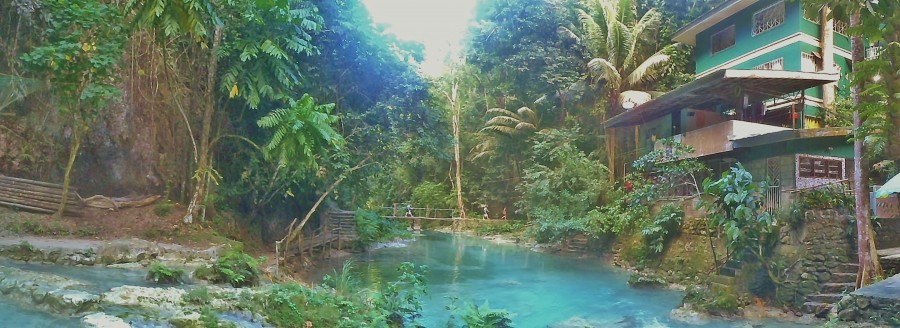
A blue river leading to the Kawasan falls.
Osmeña Peak
The next day I went on a moped a little further from Moalboal. This time I wanted to get to the Osmen Peak, which turned out to be a whole day trip. It was very interesting, because on the way I stopped again at Kawasan waterfalls, and then I traveled through the jungle, sometimes stopping on the way for drinks and grilled bananas. When I arrived at the intersection of Dalaguete, there, after nice tea I drove a little moped a little higher until I found myself in a place where I could start the climbing. It was windy and rainy that day, but still nice. Just in case it is better to prepare for rain.
Osmena peak is one of the highest points of the Cebu island, which is located at an altitude of 1013 meters above the sea level. Osmeña Peak offers a dramatic view of jagged cliffs overlooking the sea in the distance. Locals often compare the views to the Bohol’s Chocolate Hills, but here instead of round brown mounds, the hills have sharp, protruding peaks. The very trail leading to Osmeña Peak was very easy for me. It is about 700-meter climb from the entrance at Mantalongon, Dalaguete, which I did in 15 minutes.
Osmeña Peak is located about 50km from Moalboal or about 64km drive through Dalaguete. With own moped, and through the jungle, the trip would take about 1.5 hours. Osmeña Peak can also be visited from Oslob. The distance is similar. I got to Osmena by my own moped from Kawasan, which is also a good way to do this trip.
Cambais waterfalls
The Cambais waterfall is located about 1 hour by motorbike from Moalboal, and about 30 minutes from Kawasan, near Alegria. Cambais waterfalls is yet another fairytale place hidden in the jungle, where you can jump into a blue pool from a couple of heights. On the first level there is a blue pool surrounded by ferns, rocks and trees; and a limestone wall, on which water flows with great force.

Travelling around the Philippines.
On the first level, I jumped from the rocks at a height of 7m and 10m into the pool, which seemed to be very small. It is also necessary to check the depth before jumping. I went to the second level next to the rocky walls, from which water ran down, and then I held the rope and walked on a bamboo ladder. At this point I saw another high waterfall falling into the blue pool in the Filipino jungle.
After I parked my moped in the jungle and paid 50 pesos for the entrance, the first blue pool appeared in front of me after about 2 minute walk.
Banyatan Island
Bantayan Island is a large island located on the west side of the northern tip of the island of Cebu. It is an area known for its wonderful beaches and a relaxed way of life, surrounded by palm trees. I spent 1 week in Bantayan, and it was very nice. During the days I went to the beaches and organized trips, and the evenings I used to spend in town bars with pool tables. I stayed with an American man at Randy’s Resort, where I lived in a bamboo hut under palm trees, for only 400 pesos a night. Every morning I sat under palm trees with a cup of tea and thought about my beautiful life, but also about how to take control over the world.
I was moving around Bantayan on a moped, which I rented for 150 pesos for 24 hours. On the way to the picturesque beaches I often stopped for rice cakes, baked by local Filipinos under palm trees. I was in several small towns, in a water cave, and did kick-boxing.
I stayed by the port, in the pleasant town of Santa Fe, which is surrounded by wonderful beaches: Alice beach, Sugar beach and Paradise beach (with spectacular rock formations). All those beaches were beautiful, all had white sand, palm trees and fishing boats. There were also local people, very genuine, those who smiled to me for free. I like Filipinos for that.
There is also a beach called Poblacion, which is long and wide, and it is located just before the entrance to the centre of Santa Fe. You can also go there there to see kites.

Another great beach during my travels. This time it is the Bantayan island.
Because I had a moped, I organized several trips outside of Santa Fe. On the way to Paradise beach I stayed in the Ogtong cave. It is a water cave, located in the area of a hotel. Fortunately, people who don’t live there can buy a ticket for 100 pesos. I sat in a cave for about an hour, swimming from one shore to the other and watching rock formations on the ceiling.
I also went to Bantayan town, which is the administrative center of the island, and which lies about 10 km from Santa Fe. I will always remember this small town as a big square with many shops and a nice church. I also advise you to see the promenade by the sea, from where the ferries sail to the Negros island.
Another place worth paying attention to is Mangrove Garden & Eco Park, a forest covered with mangrove trees. I entered the wooden bridge and then continued onto a bamboo tower. Mangrove forest is an extremely unique marine ecosystem close to the mainland, which I previously saw in Thailand, Malaysia and Brunei. That park was an exceptionally beautiful place, because I was walking on a bamboo footbridge, over blue water, and I enjoyed mangrove trees protecting me from the sun. On a clean white sand on the shore local Filipinos sell grilled meat and coconuts under palm trees. It was one of those places that I didn’t want to leave.
I also took a trip to the northernmost city of Bantayan – Madridejos. As I could have expected, it was very nice. Luckily, I witnesses a small carnival. Young people were dressed in funny uniforms, they sang and danced. First I walked on the pier over the blue sea, and then I spent time with people, having fun. I noticed that Bantayan island is very popular among white people, who run away from the high prices and political shit of Europe and America, and chose a peaceful life on a tropical island.

The beauty of Bantayan.
Trips to the paradise islands near Bantayan
When I spent enough time on Bantayan, I decided to visit two surrounding islands. Each of them is different, also because of different prices.
Virgin island is a private island with a white strip of sand, turquoise water and palm trees, that invite tourists to a small paradise on earth. Throughout the day I swam from one raft to another, I walked on the rocks and admired the sea views. I paid 500 pesos for entry, and 600 pesos for the boat. Unfortunately, it was not cheap, that’s why I advise to sail in the morning. I didn’t find out how much it costs to spend the night on the island, but I didn’t expect special discounts. It was a beautiful day.
Hilantagaan island is fortunately cheap, because it is not private and it is a home to a small fishing village. It is still beautiful, there are of course nice beaches and fishing boats, but Hilantagaan is a place for those tourists who want to see the authentic life on the Philippine island, without tourist amenities. I got to the island by a water taxi for 25 pesos one way. Nature was attractive, but not as enchanting as on the other islands.
Malapascua Island – my beautiful 3 days
The Malapscua island lies in the Sea of Visaya, north of Cebu and west of Leyte. Malapascua is a small island because it covers an area of only 2.5km by 1km. This island however is a very popular piece of paradise, known not only in the Philippines, but also in the world. Of course, there is a landscape taken from a perfect postcard, with white sand, turquoise sea and coconut palm trees, that give shade in a hot climate. However, Malapscua has something else, and it is a diving.
In the waters around Malapscua you can see small colourful fish, big rays and sea turtles, but the main point of the program are tresher sharks. Tresher shark are massive fish of about 6m in length, with a very long, and very characteristic tail that waves in the water behind its head. I dived twice and saw this shark in the natural environment, which of course was an experience. I will also add that although tresher sharks are predator,they are not dangerous to humans.
Similarly to Oslob, where the whole area lives on shark tourism, based on the observation of whale sharks, Malapsuca is probably also the center of attention because of sharks. Sharks therefore save Filipino economy. When in Malapsuca I bought a t-shirt and magnets with a tresher shark, although there are also many other souvenirs associated with that unique animal.

Beach in Malapscua island.
Apart from diving I spent nice time walking on the beach, and I had good meals among nice views. I also had clean room for 400 pesos. I really didn’t want to leave that beautiful Filipino island, especially that I realized that I would soon have to return to the expensive, problematic and depressive England.
My last day in Manila
Then I flew to Manila, where I spent 2 nights and 1 day. I stayed in Makati, because it was the most convenient. Makati is known as a business district, but in my opinion it is rather a district of whores and transvestites, and sellers of viagra. Walking down the main street, a white man is always whistled at and encouraged to have sex, even if he only wants to go for a dinner in peace.
When I was standing on the street, I had an interesting meeting. Well, the girls circled me to provoke some action. However, it got much more interesting when I was approached by an Arab, who lived permanently in the Netherlands, and who of course was with a Filipino prostitute. He asked me if I was going to bang something tonight, to which I replied that I would rather not. Then I asked him how long he had been in the Philippines. I asked if he saw whale sharks, waterfalls and beautiful beaches, but he quickly interrupted me and said that he didn’t car about any of that. He only came for whores for two months, and set a plan for two women a day, what means that within two months he wanted to have 60 women. At the end he smiled and said that Holland paid him benefits purely for that purpose.
The best thing however is, that the Dutch, German and Swedish women, who I met during my travels were fierce feminists who were open to the exotic immigration, but at the same time they approached the Pole with great reluctance, while showing their hearts to Muslims. In my opinion, white women are useful idiots that destroy white Christian civilization through their harmful leftist ideologies. If Muslims were the only problem in Europe, then in my opinion this would be half of the problem.
Apart from that, the traffic is very tiring. When in Manila, on my last day I went to the Rizal Park, where I had some rest. It was already December, that’s why I saw a big Christmas tree in this Catholic country.

This journey has come to an end, but it is not the last one.
I soon drove to the airport and left the Philippines, dreaming of return.
Summary of the trip
In 2018 I travelled for 4 months and saw the wonderful peculiarities of nature, beautiful landscapes and interesting cultures. I appreciate every moment of the fact, that I can travel and discover the world through its realism, not through the screen of the Polish language media. I wholeheartedly recommend a trip to the Philippines and the island of Borneo. It is a beautiful part of Asia.
- Bandar Seri Begawan (BSB)
- Bantayan Island
- Bohol
- Borneo culture
- Borneo jungles
- Brunei
- Cebu City
- chocolate hills
- East Malaysia
- jeepney Philippines
- Kalanggaman island
- Kawasan Philippines waterfall
- Kota Kinabalu
- Labuan duty free
- Labuan Malaysia
- Legaspi Mayon volcano
- Leyte
- Malapascua diving
- Malaysian Borneo
- Manila Istramuros fort
- Manila Rizal square
- Mount Kinabalu
- Negros Philippines
- Omar Ali Saifuddien Brunei mosque
- Oslob sharks
- Osmena Peak
- Philippine beaches
- Philippines waterfalls
- Philippines whale sharks
- Proboscis monkeys
- prostitution in the Philippines
- Sabah state
- Sarawak state
- Semporna
- Sepilok orangutans
- Sipalay Philippines
- Siquijor waterfalls
- the smallest primate tarsier
- Trip to Borneo
- trip to Philippines
- trip to the Philippines
- Yayasan Complex



